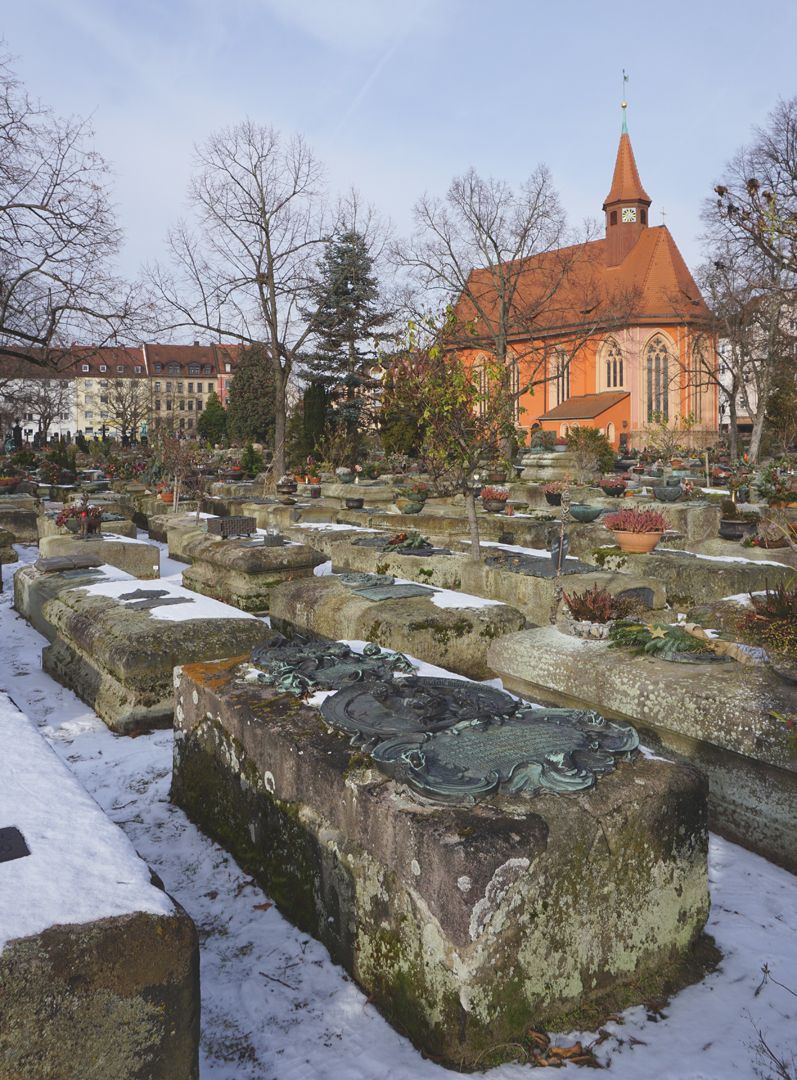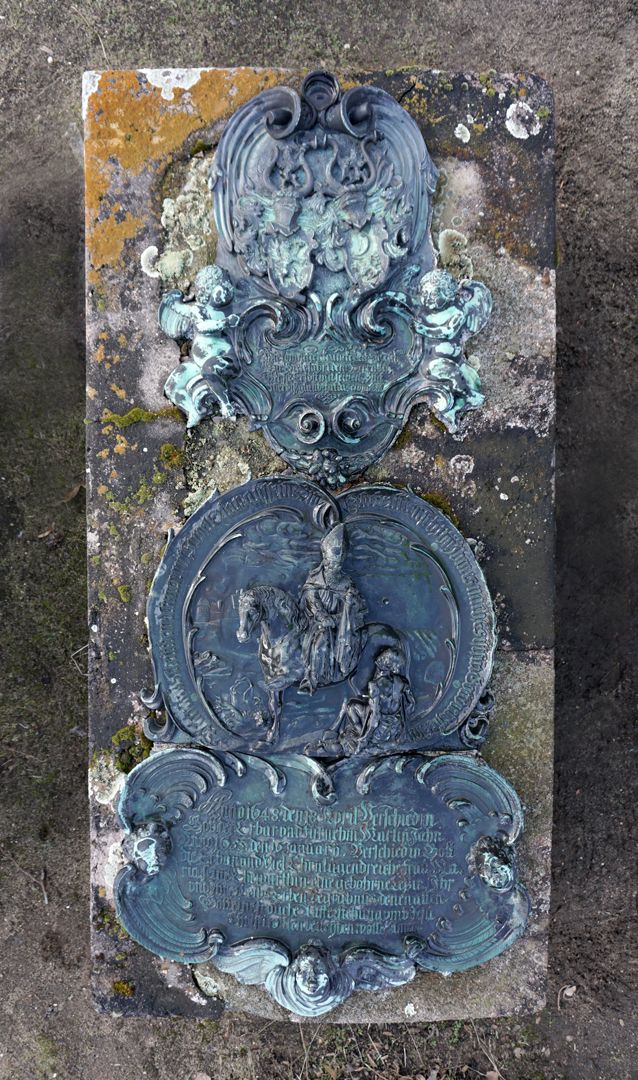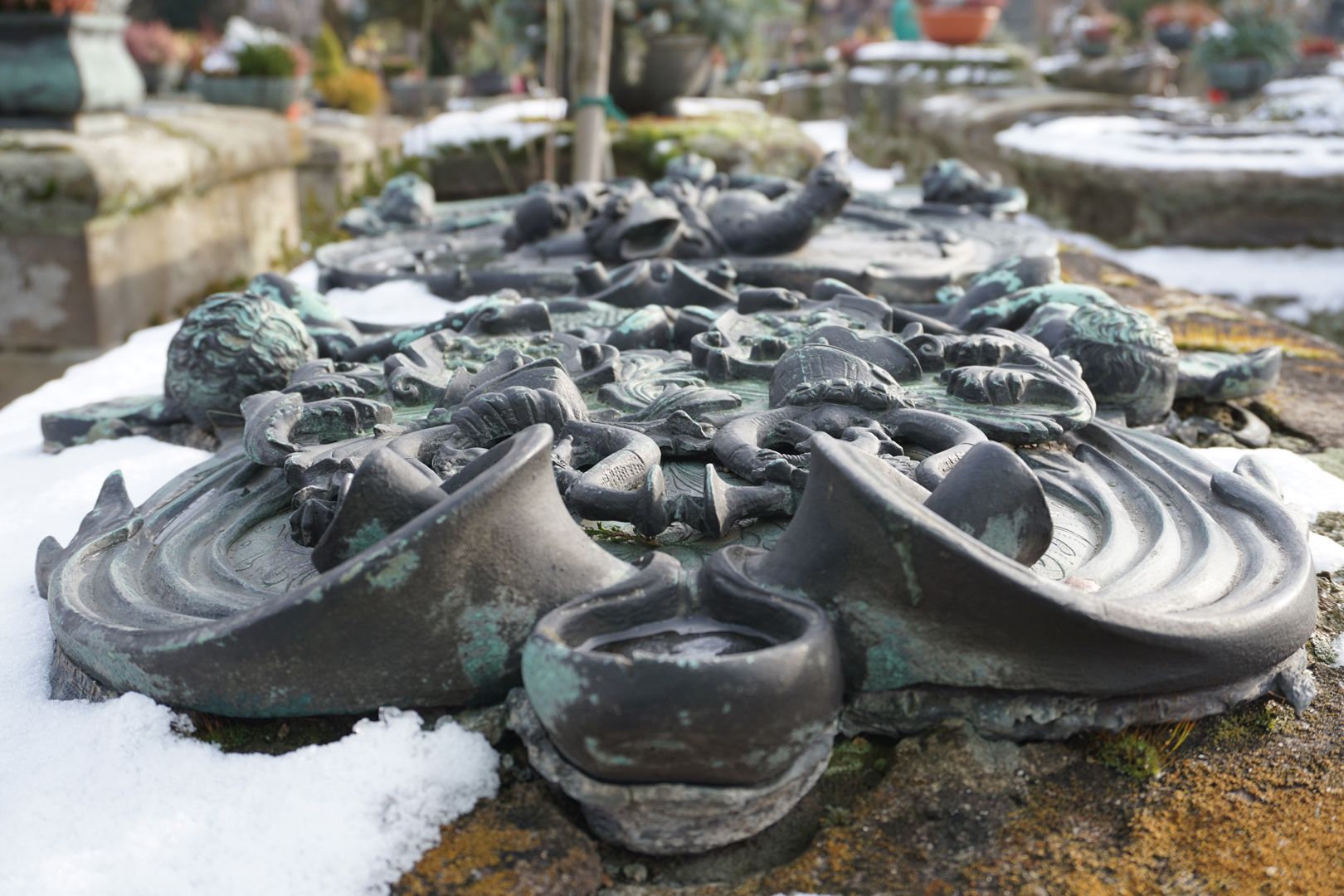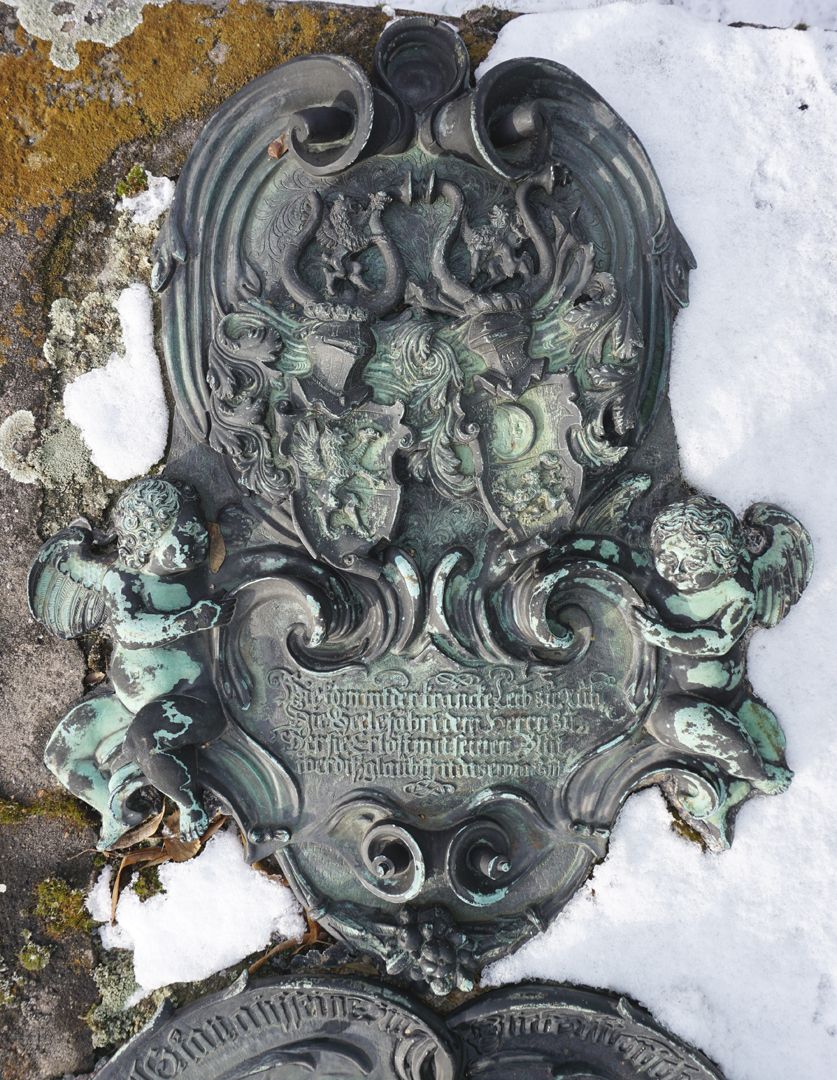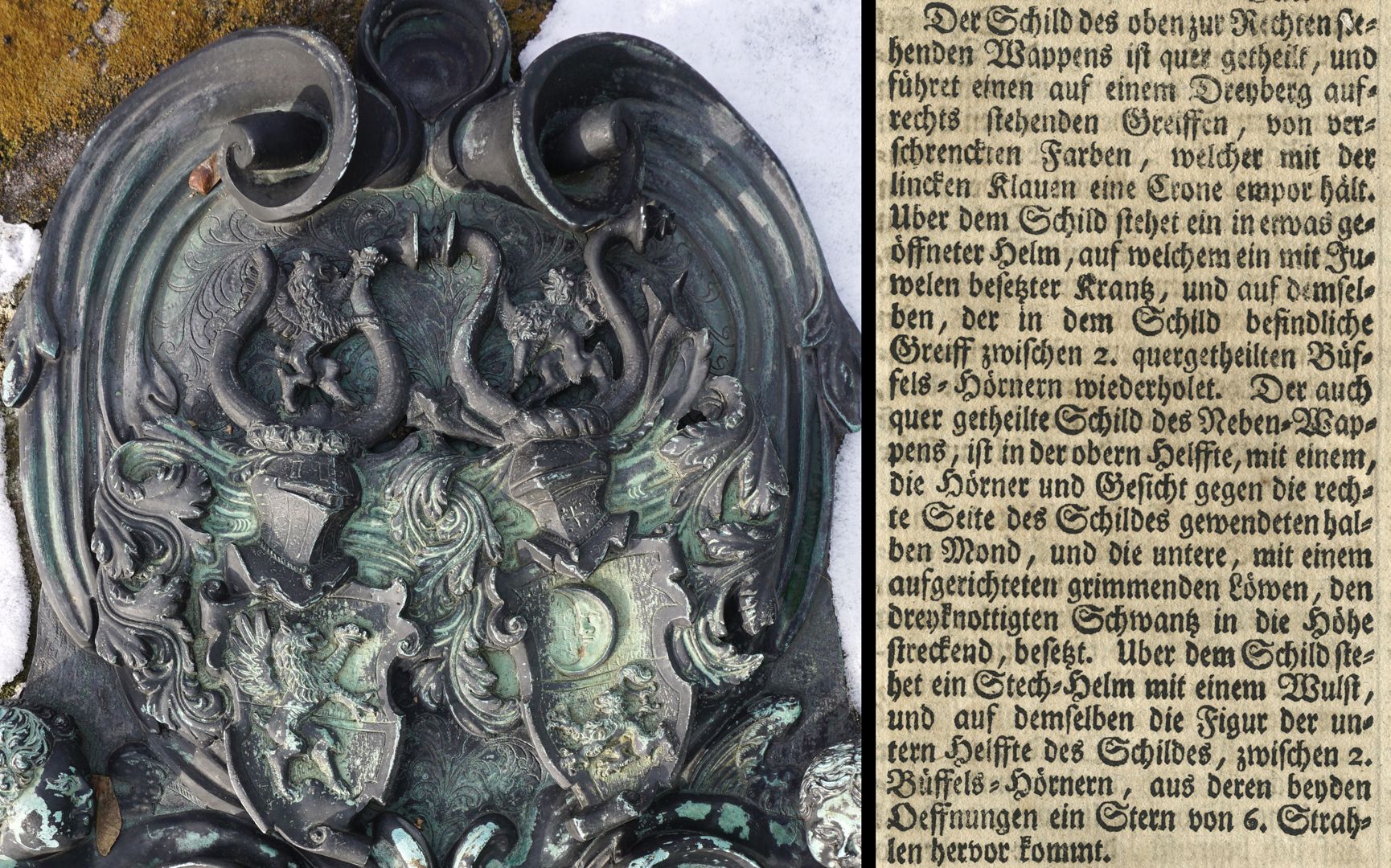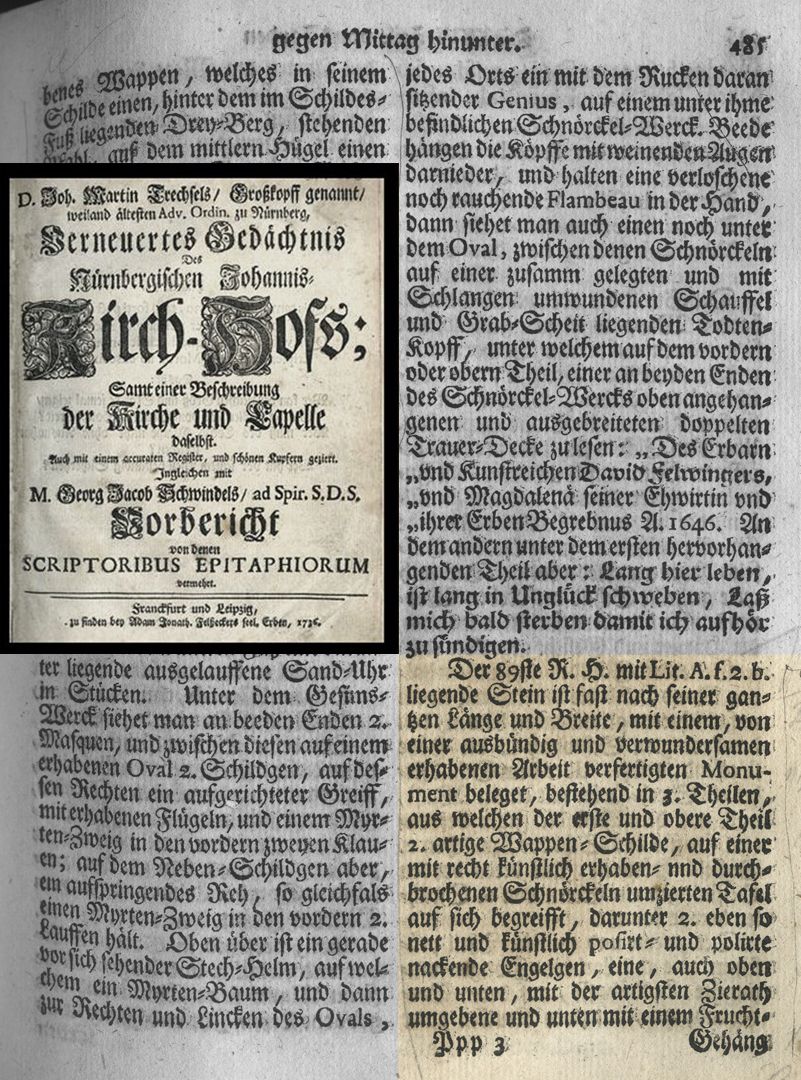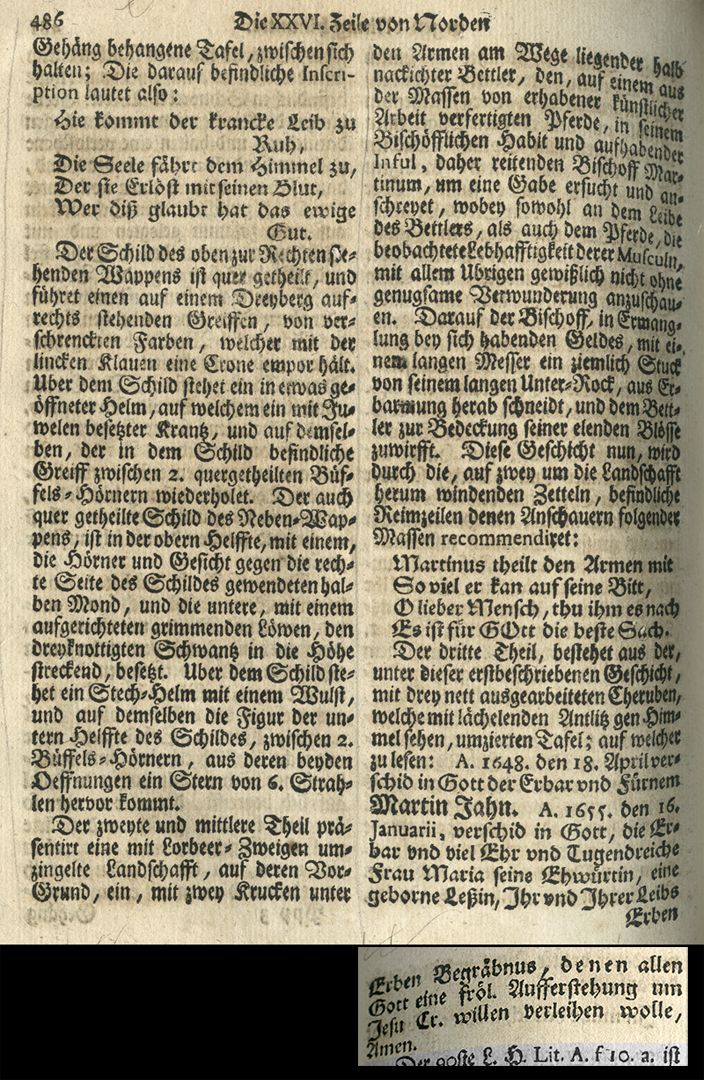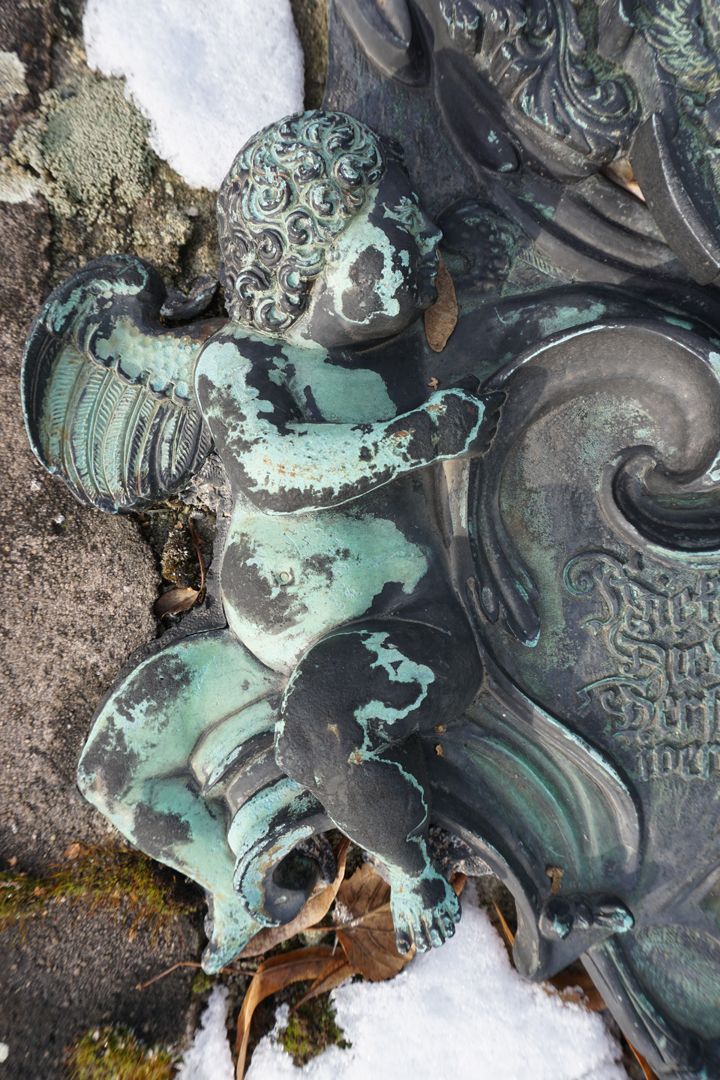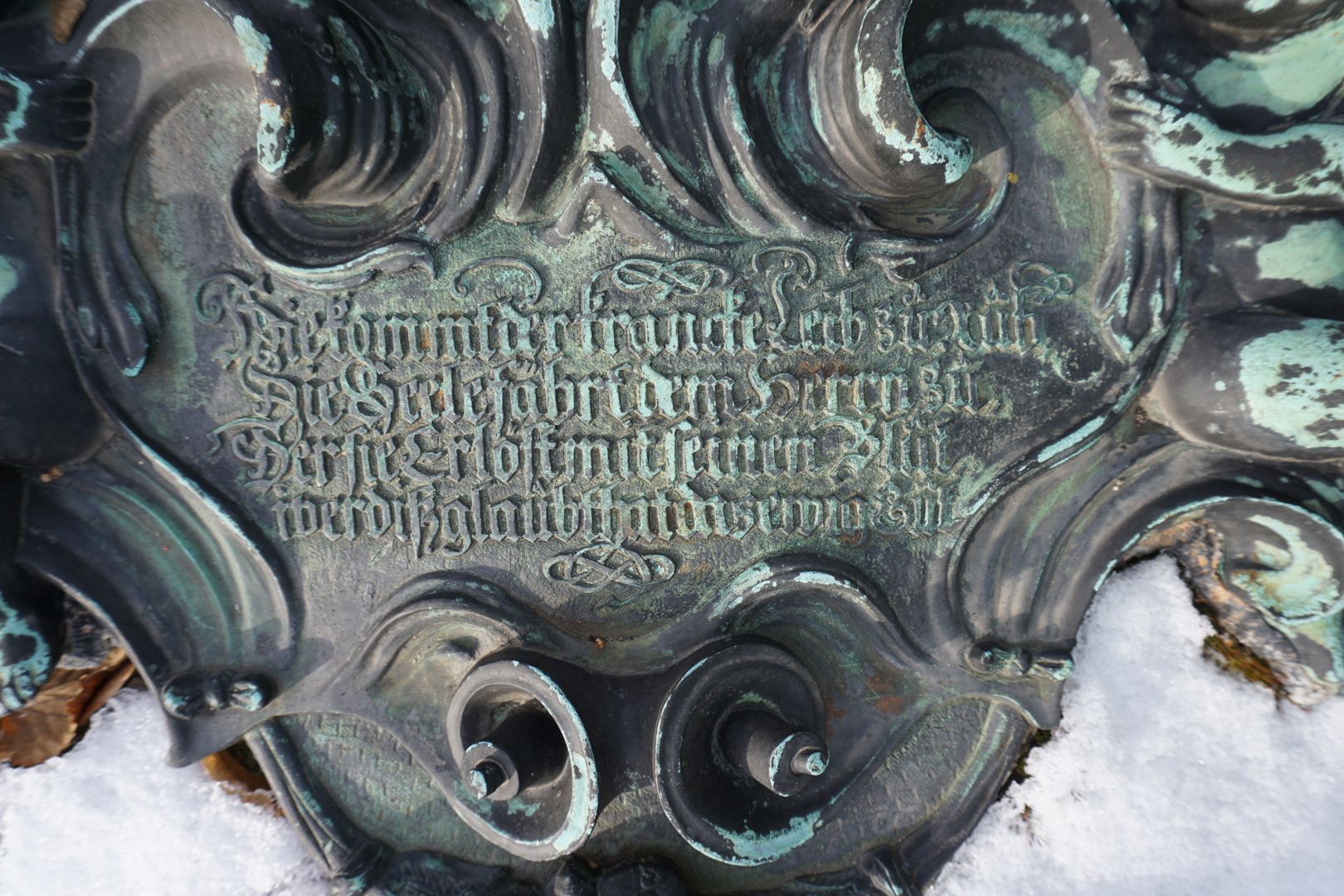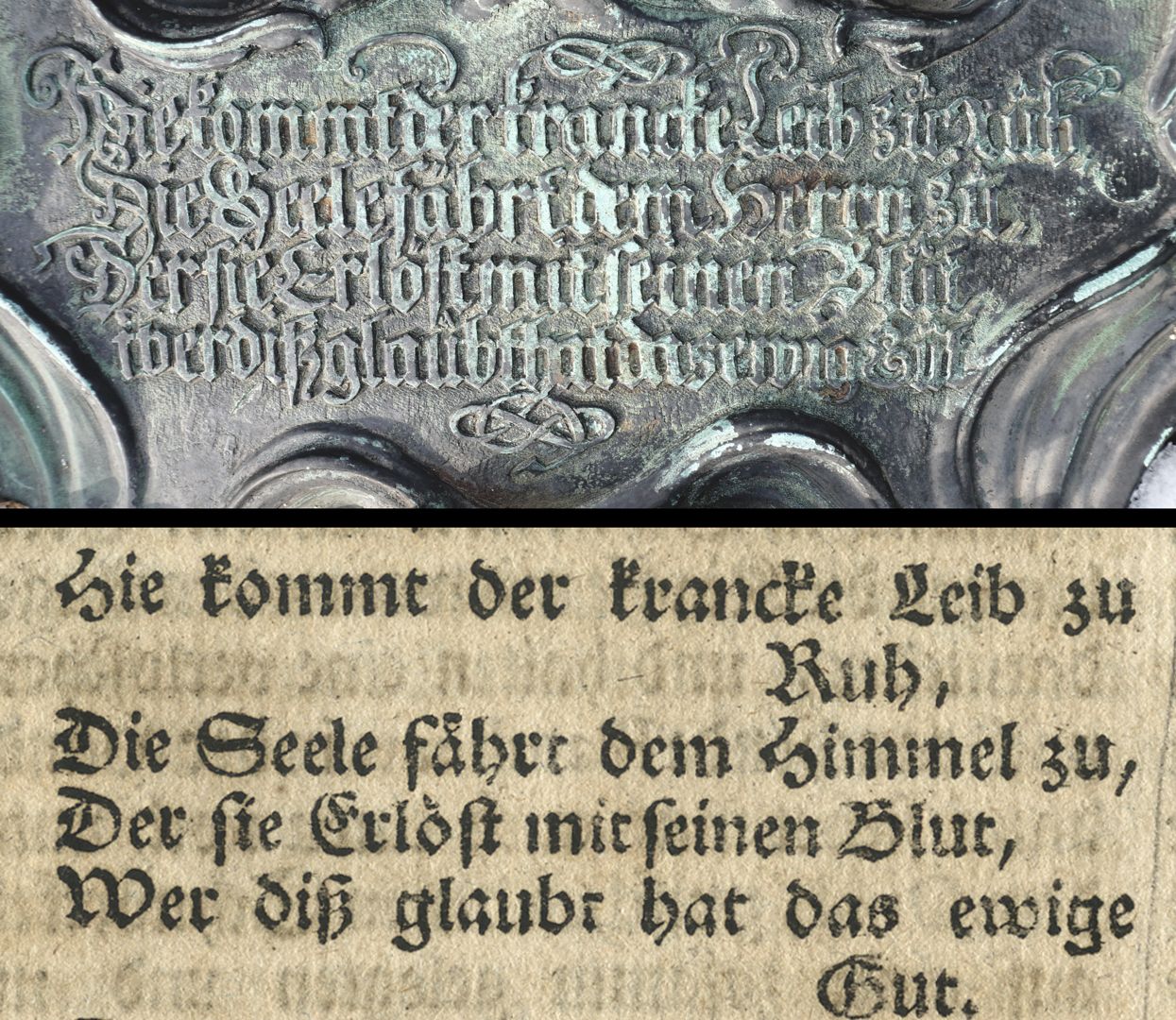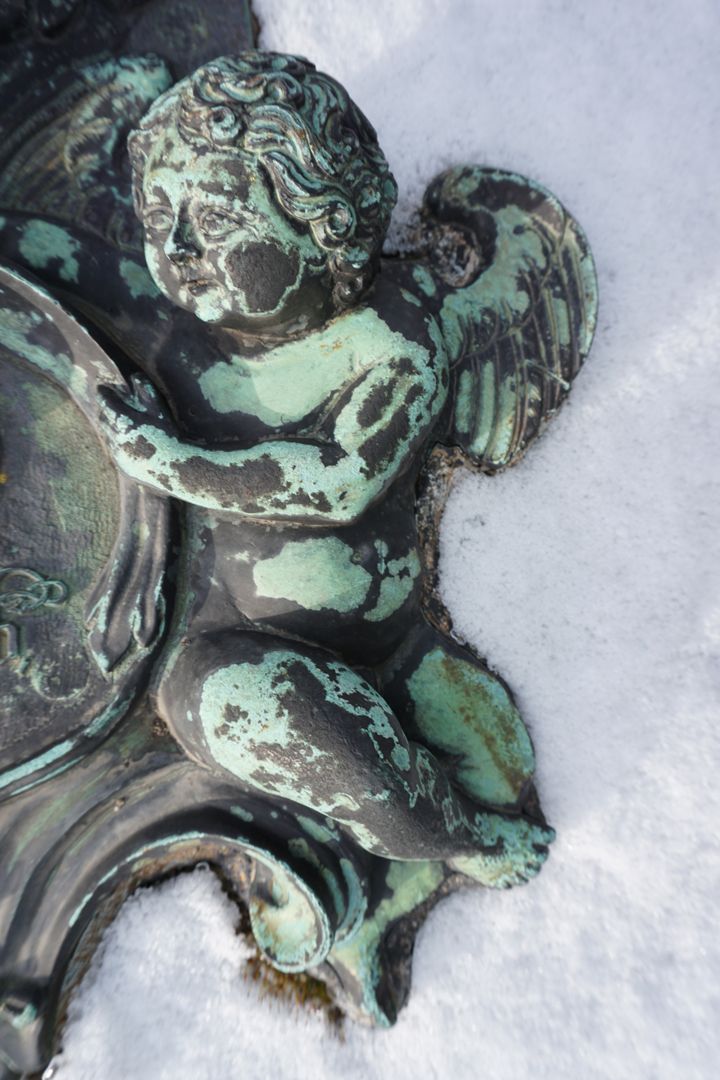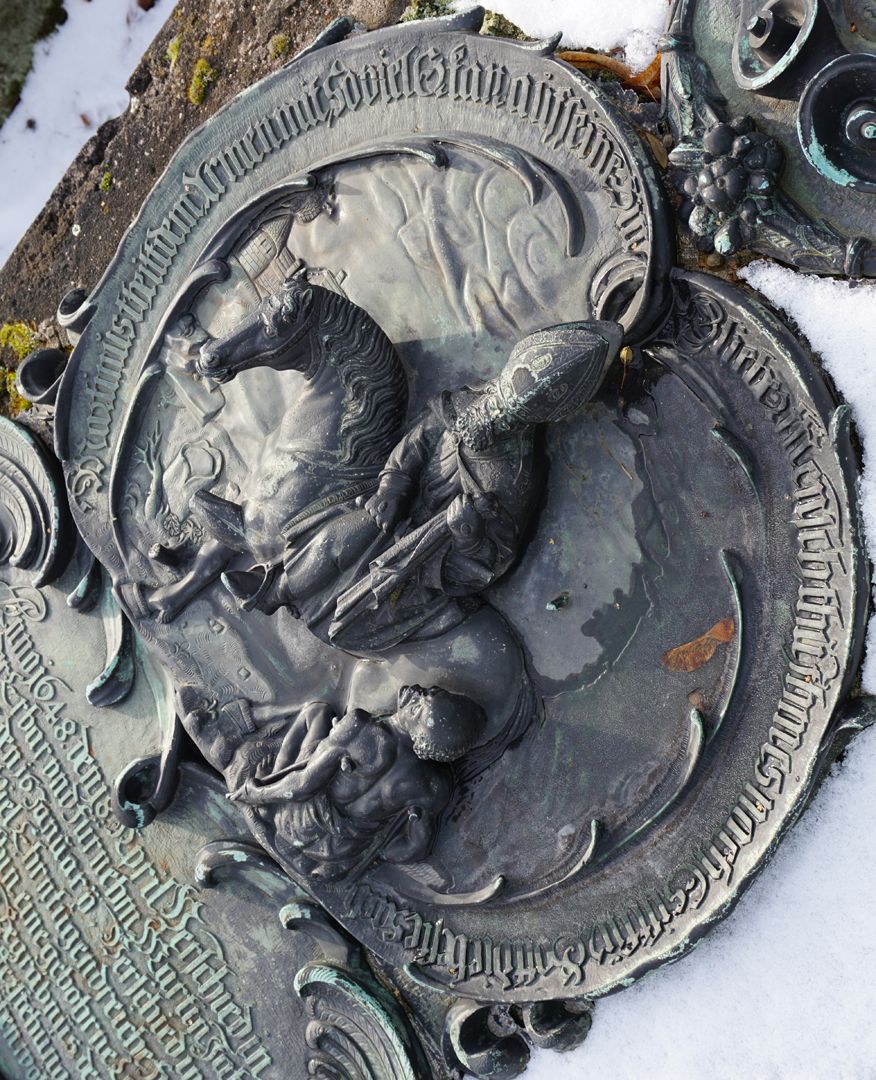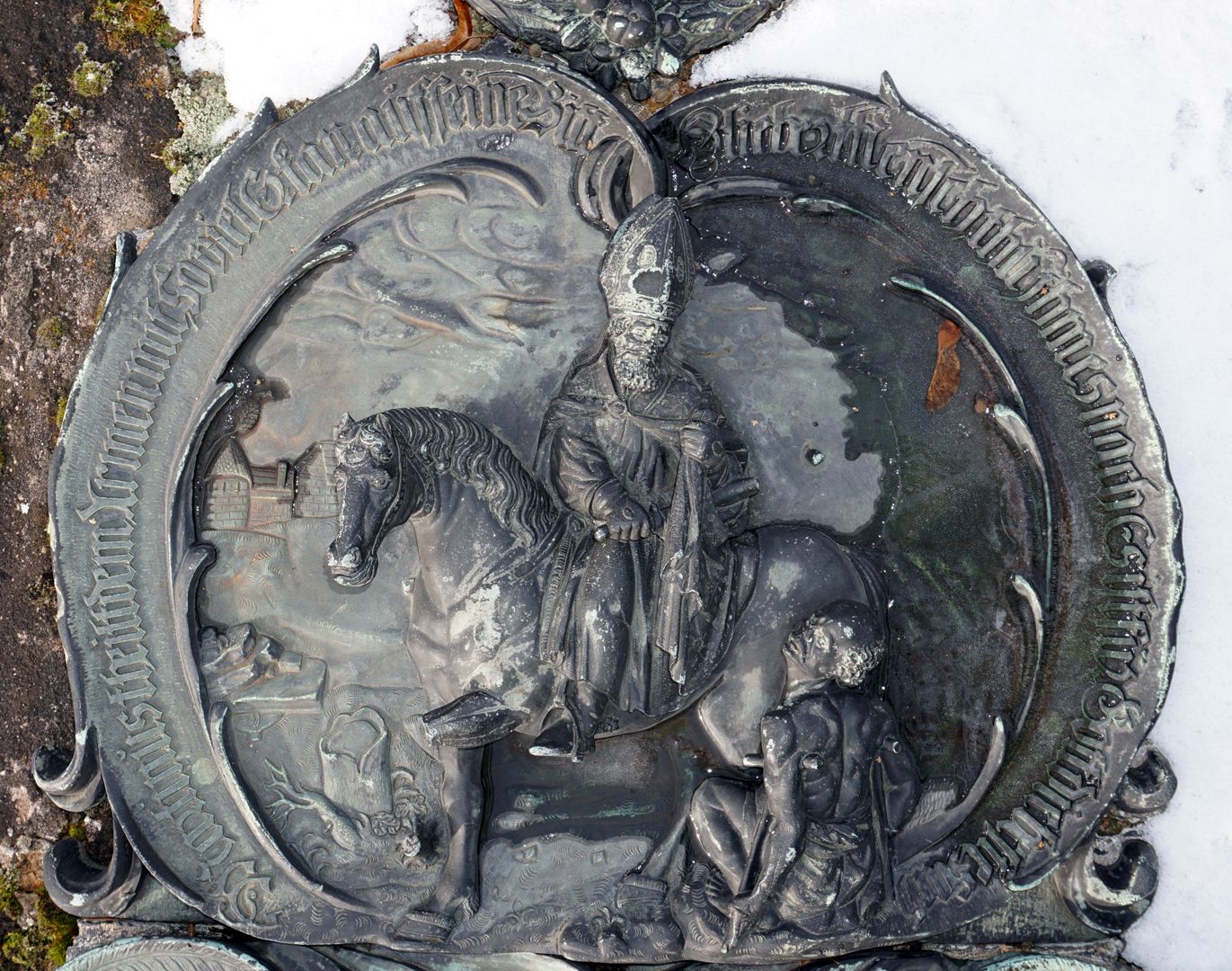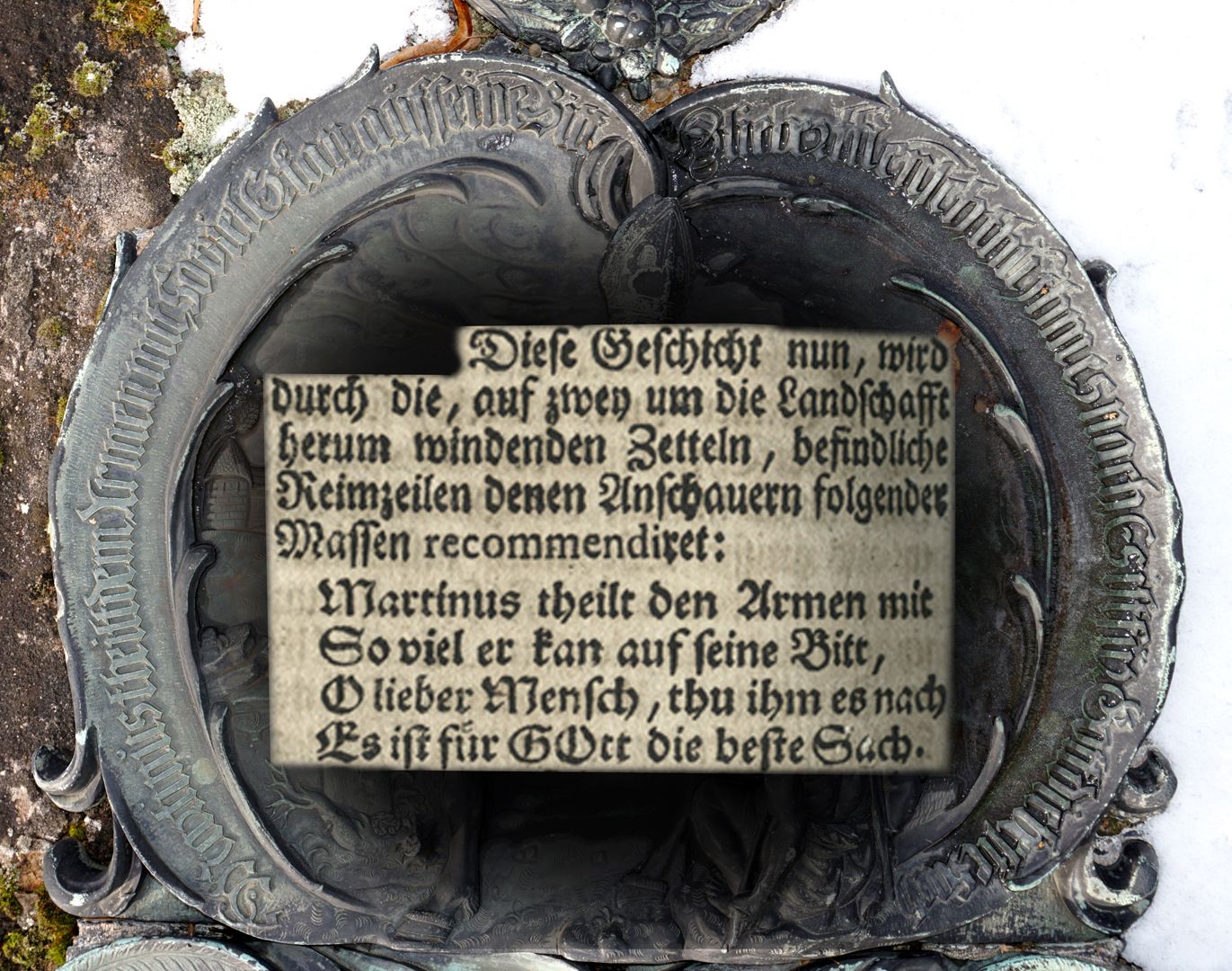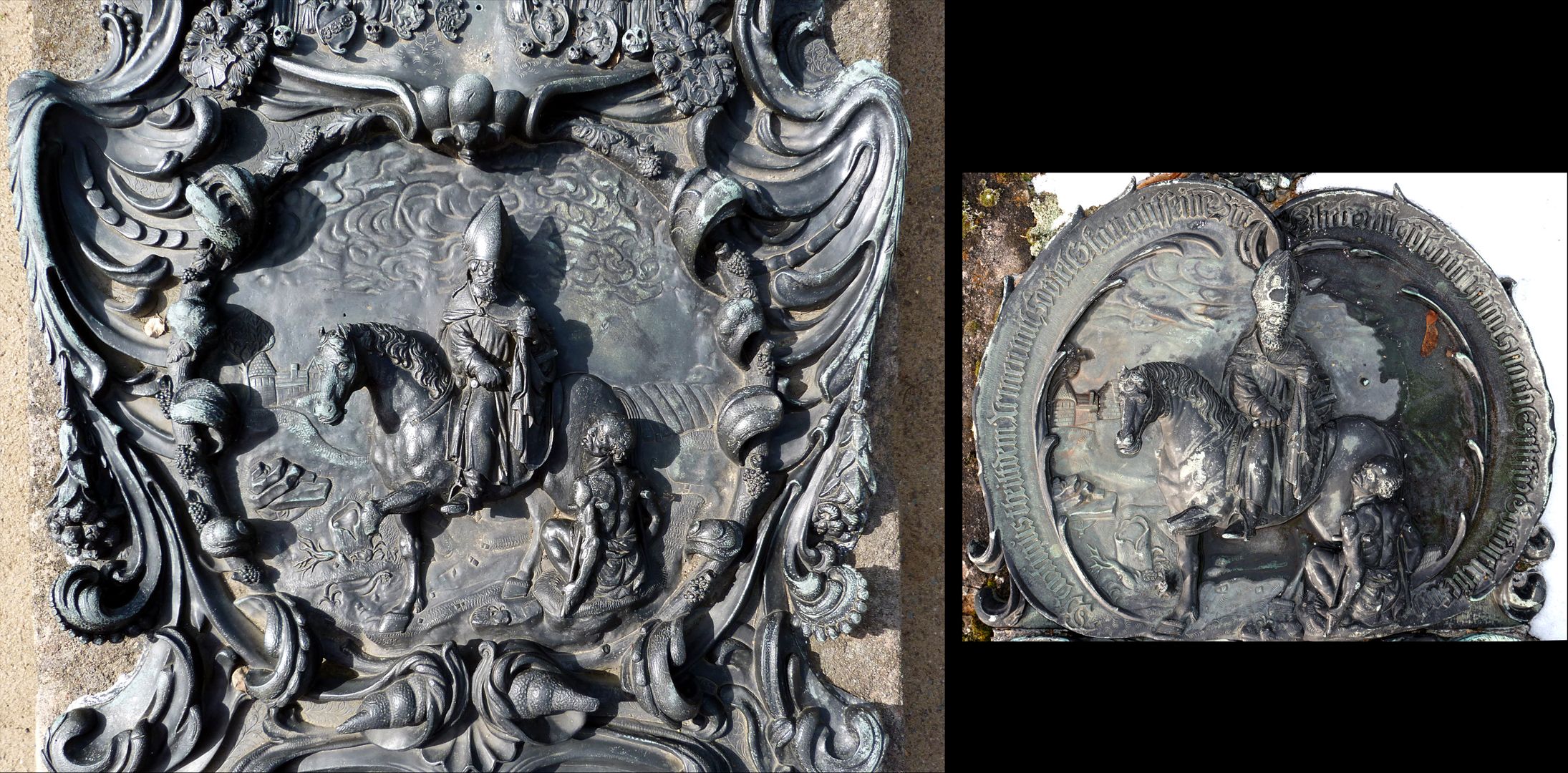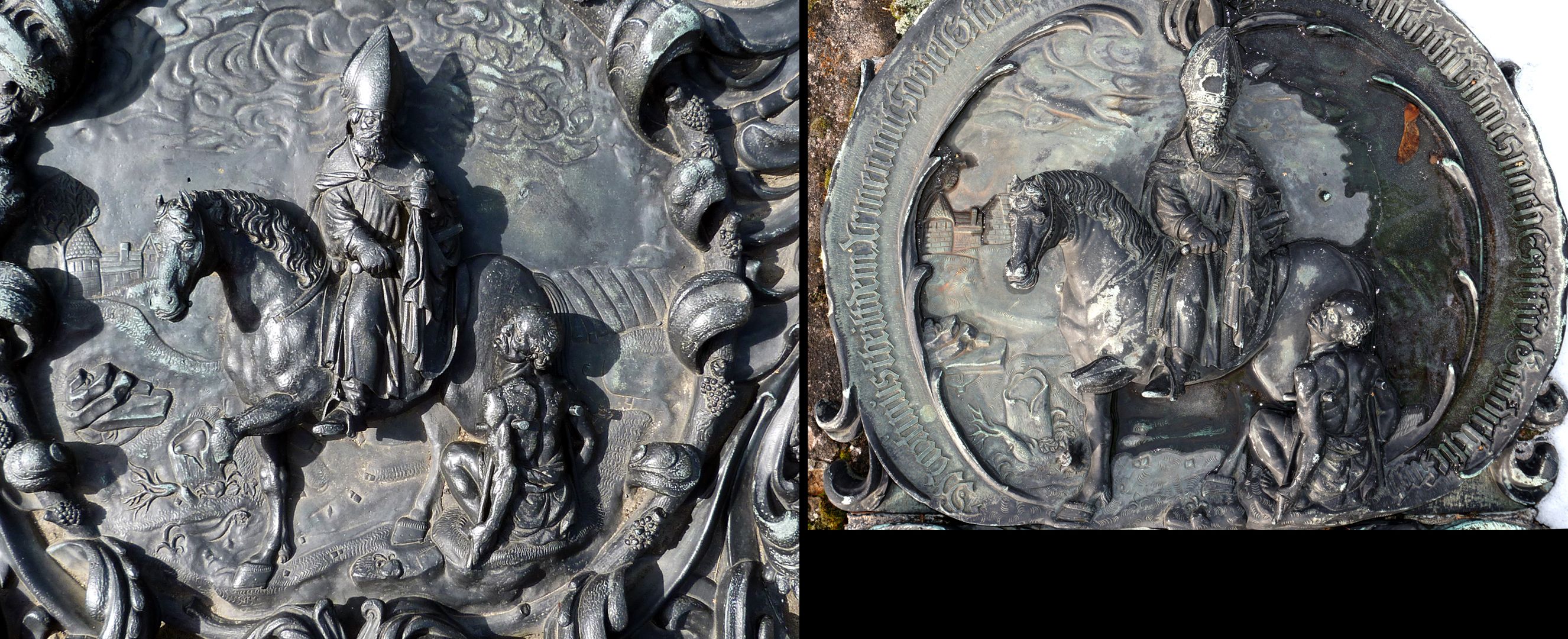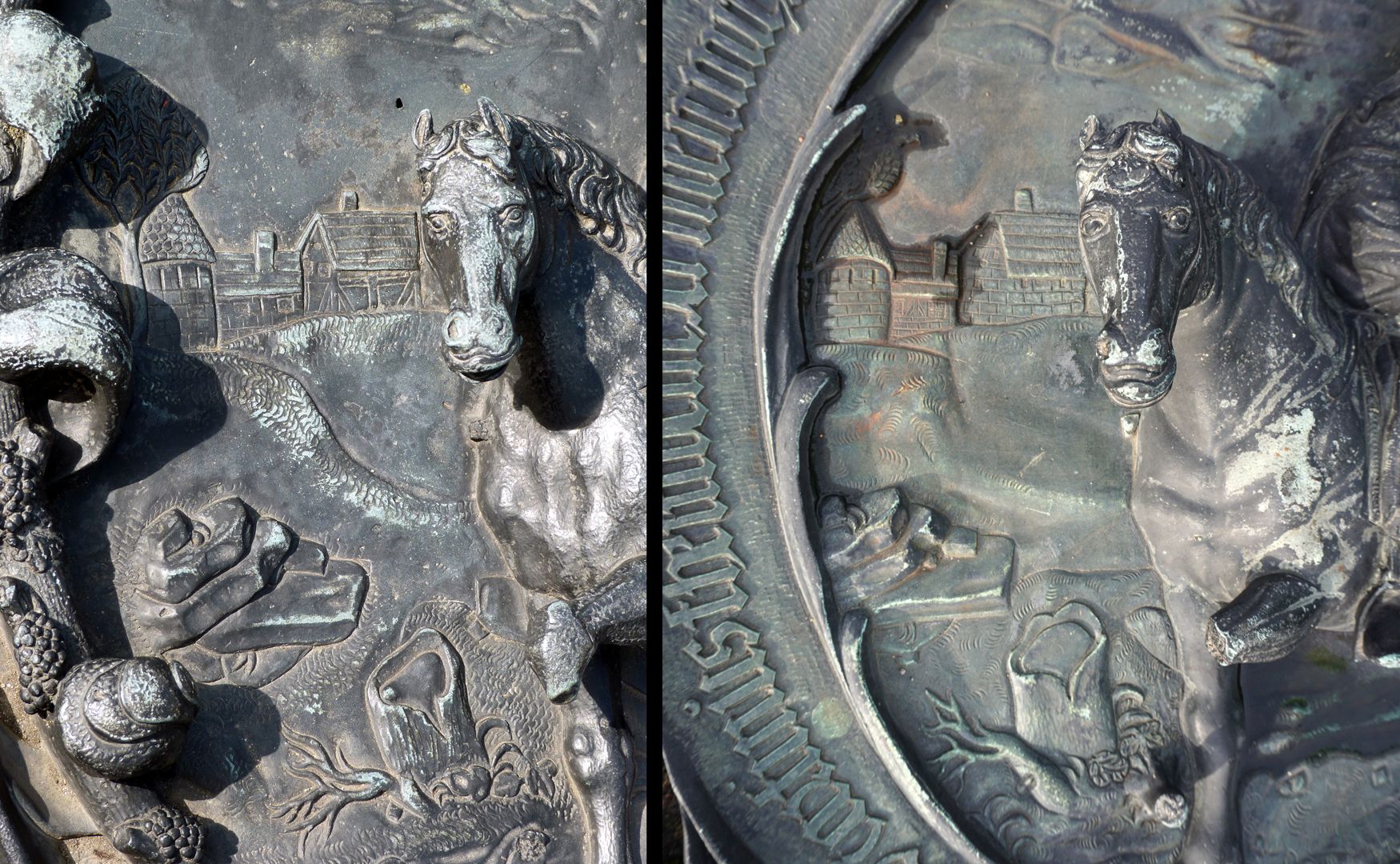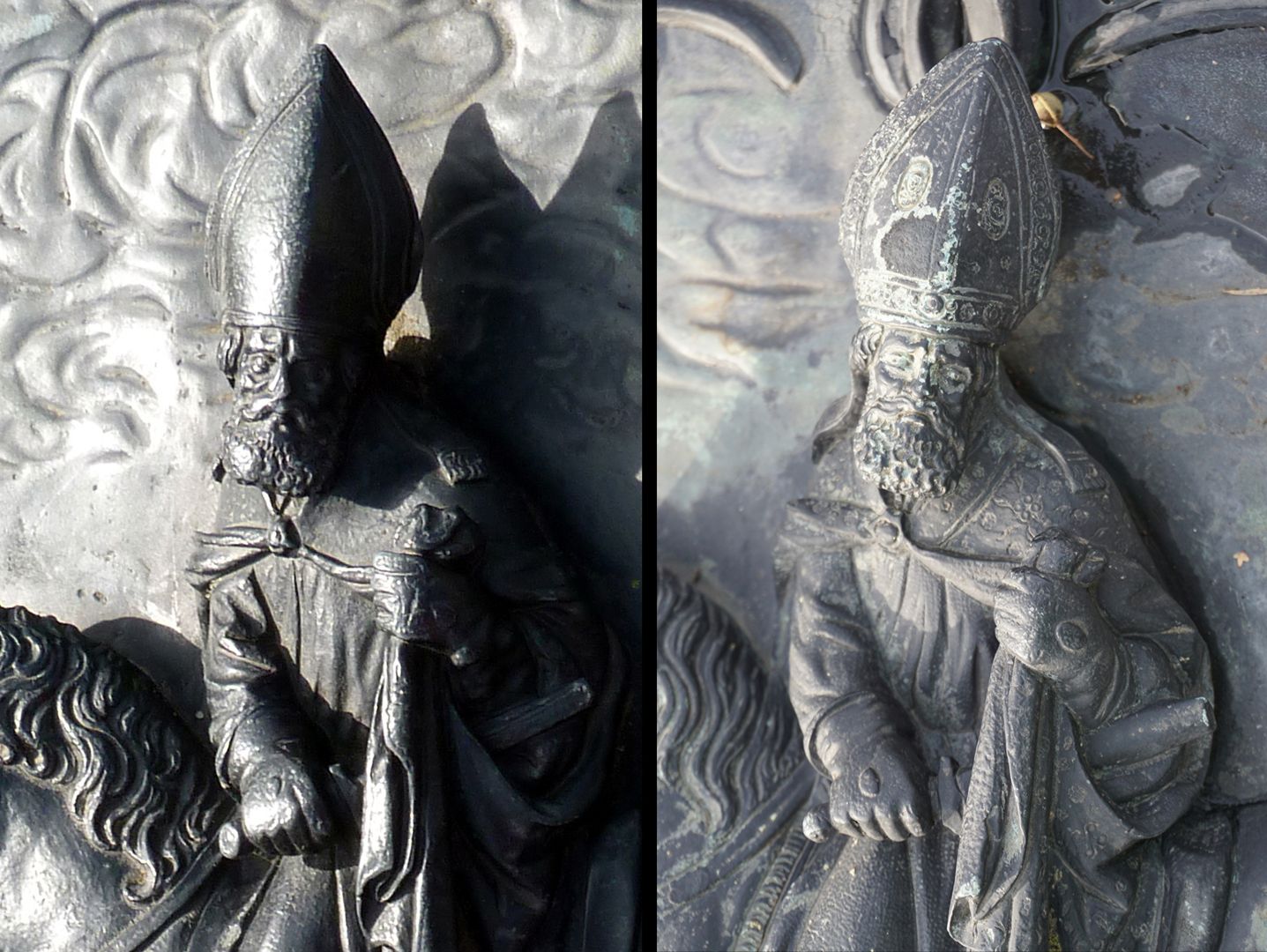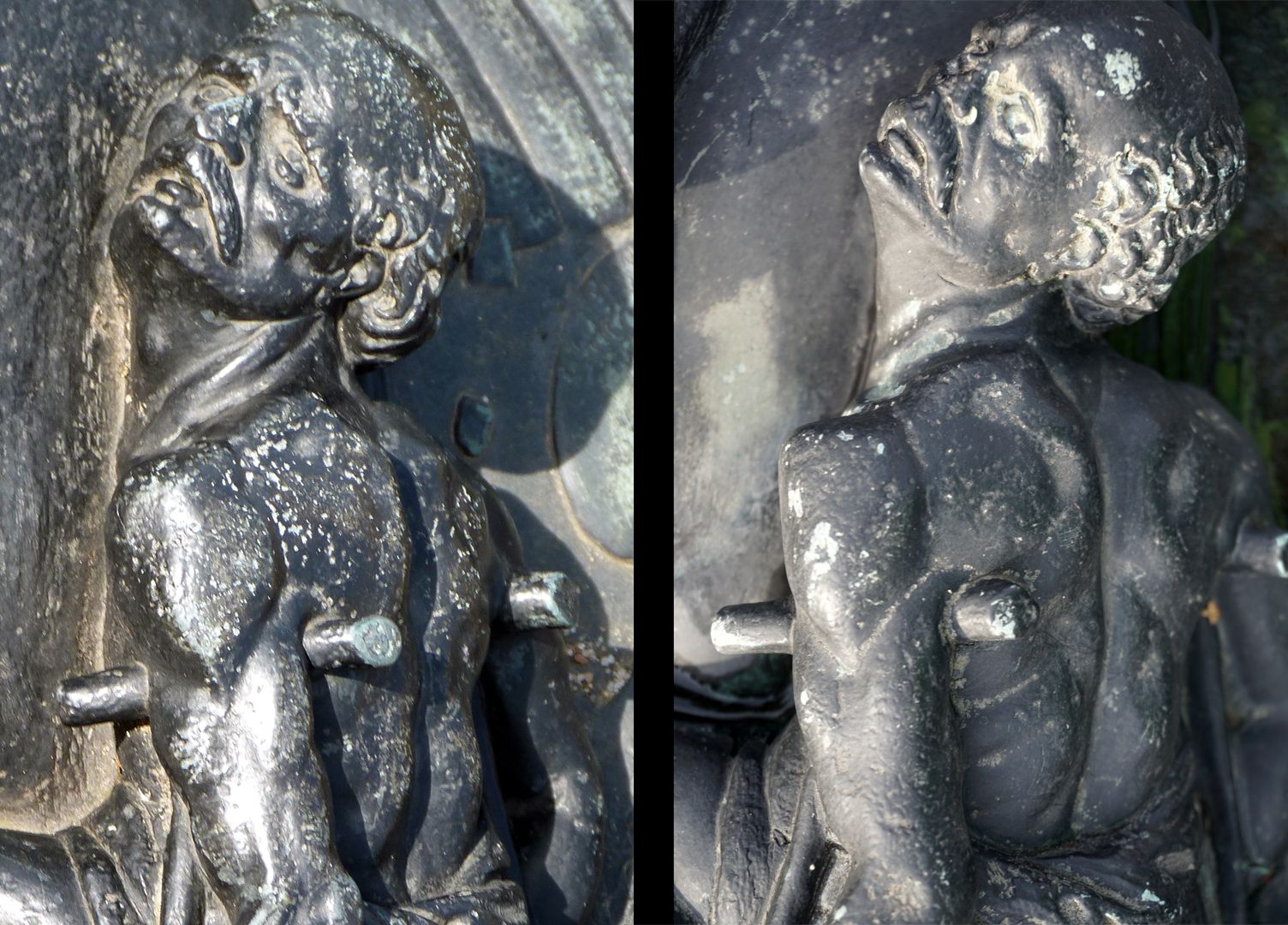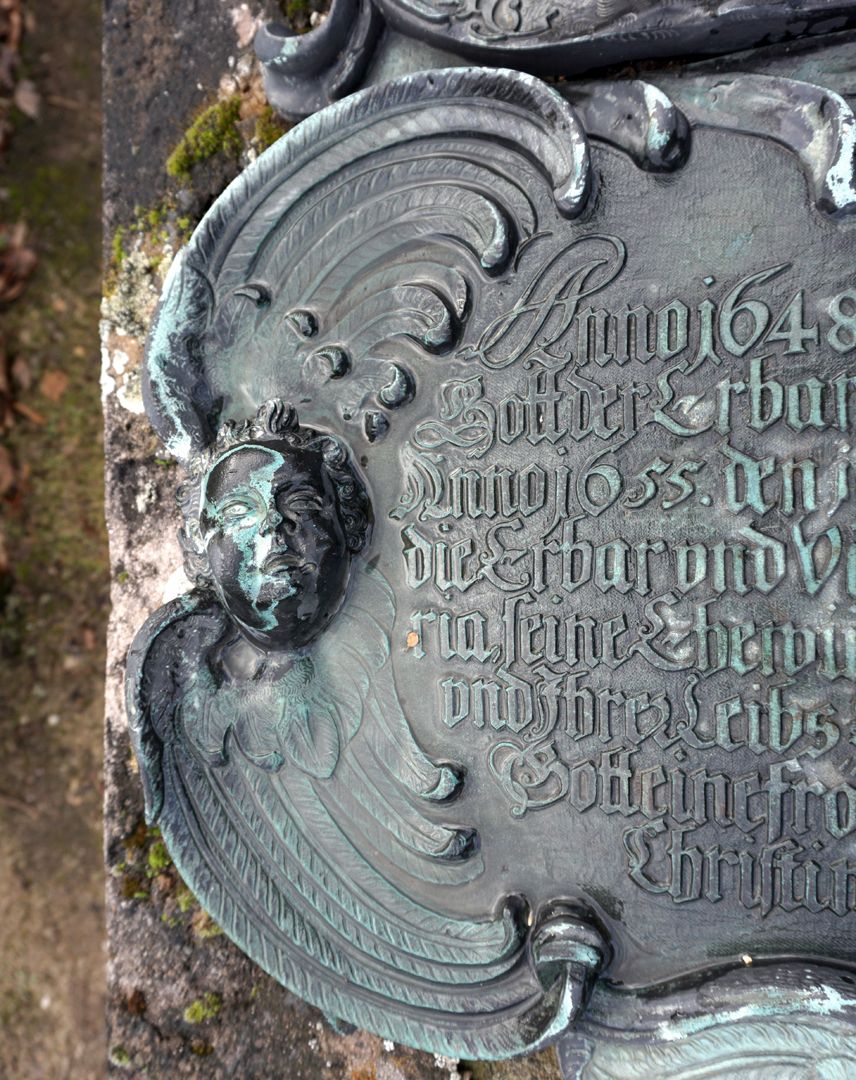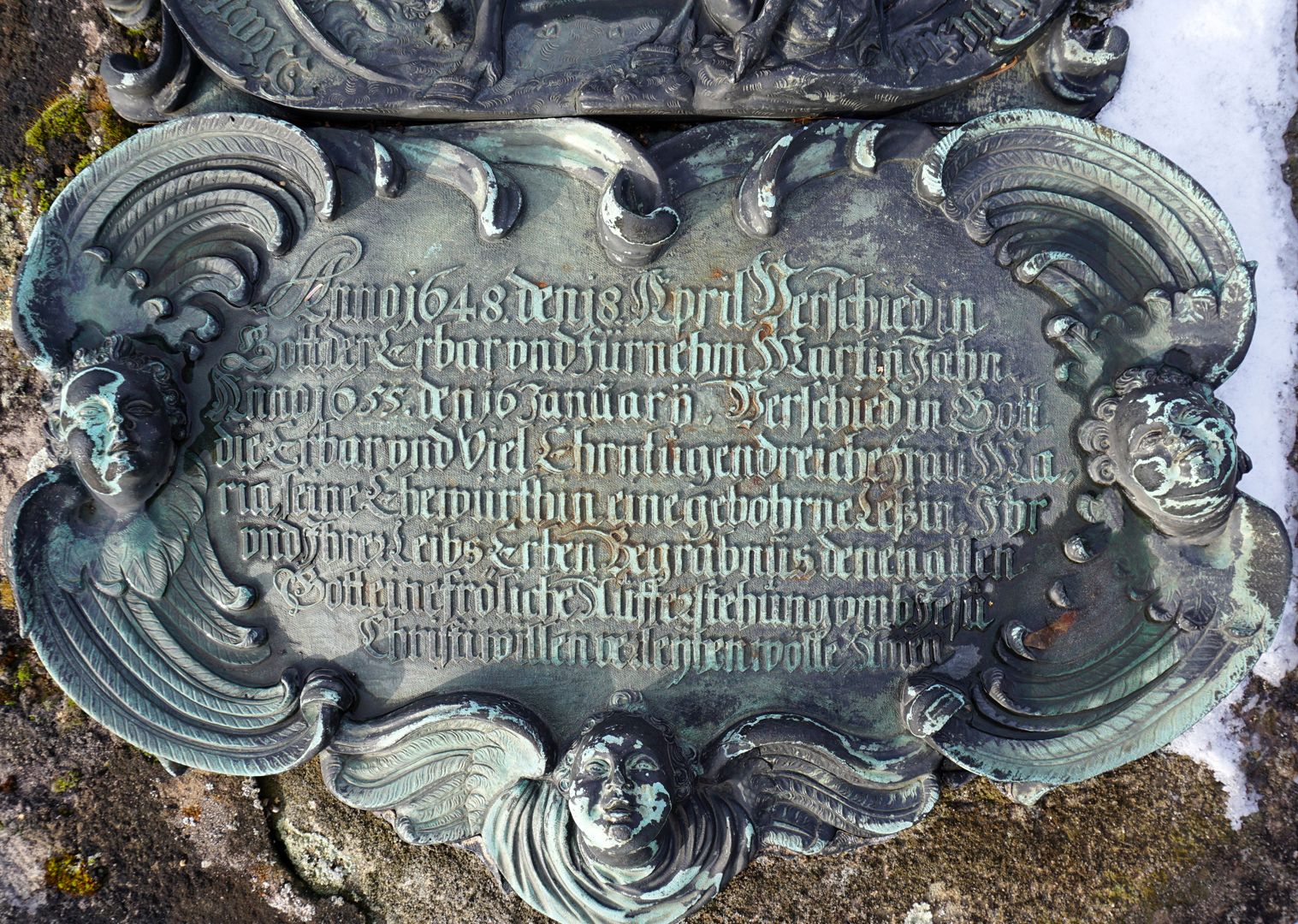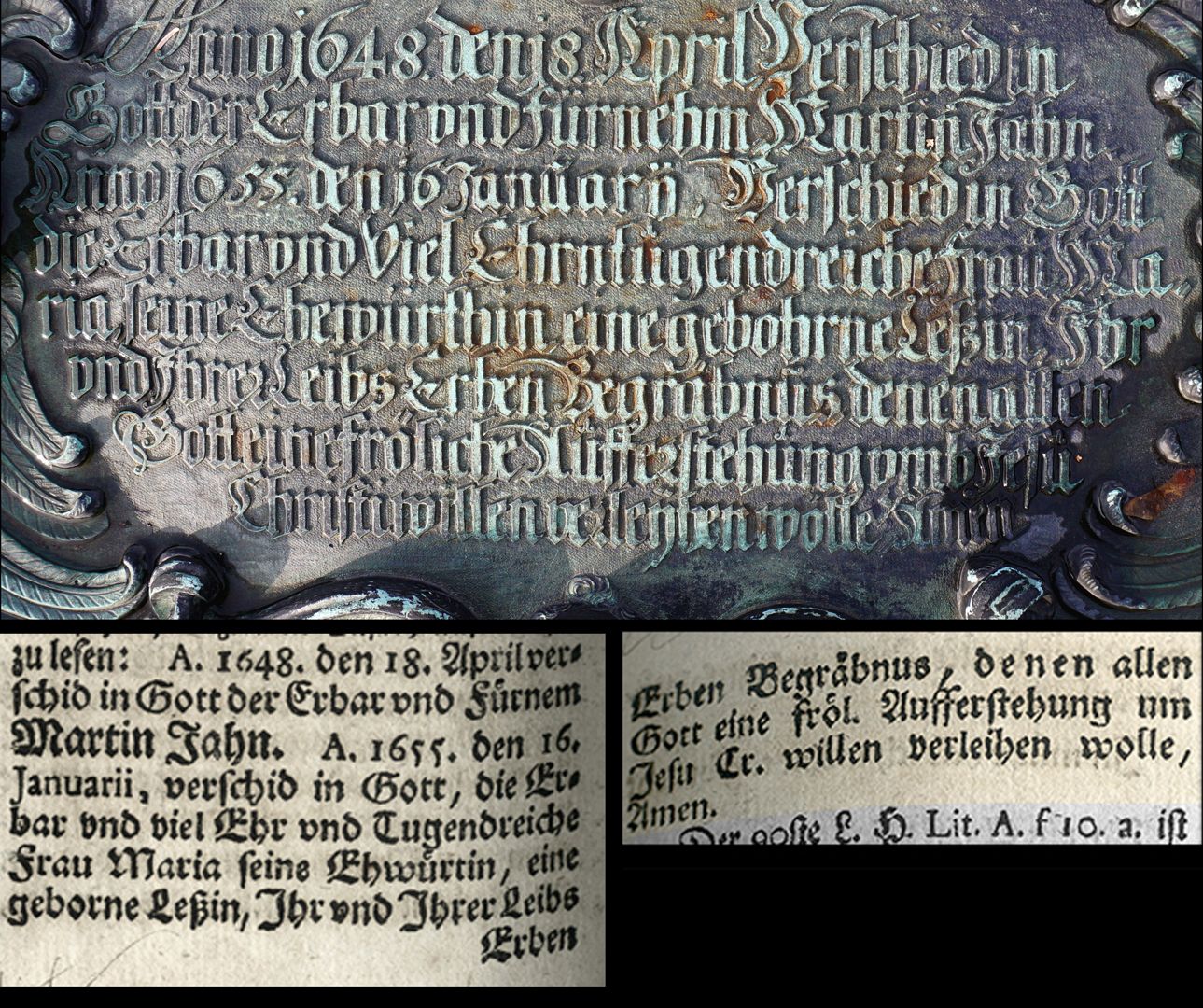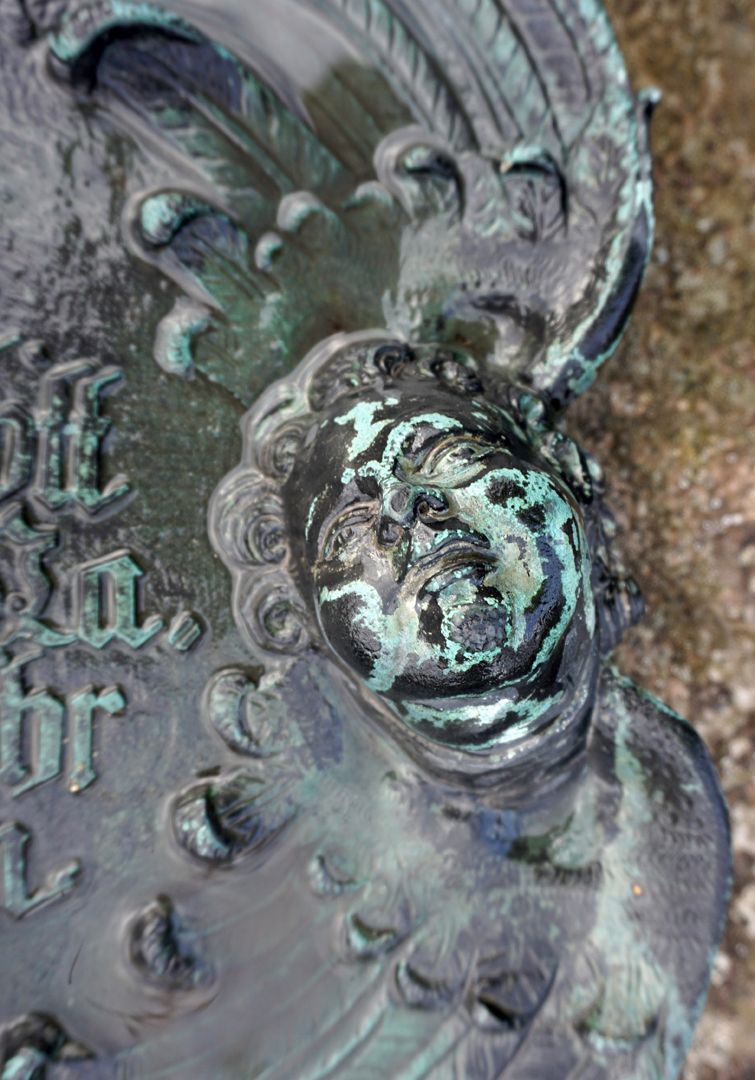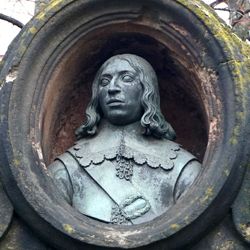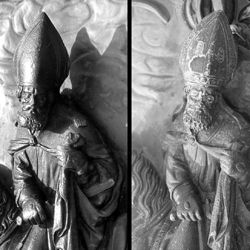Epitaph for Martin Jahn and his wife Maria, née Loß (Löß)
Epitaph for Martin Jahn and his wife Maria, née Loß (Löß)
1648
Location in the burial ground
The depiction of St. Martin with the beggar is in almost identical form taken from the grave (number: 1404) of Martin Peller. see: Epitaph of Martin Peller (d. 1629) and wife Maria Viatis (d. 1641) It is reasonable to assume that a wooden model (?) of the Peller epitaph was still available for the design. This in turn would speak in favor of the execution by Johann Wurzelbauer. See Peter Zahn: The St. Johannis, St. Rochus and Wöhrd cemeteries in Nuremberg (1609 to 1650), Wiesbaden 2013, pp. 596-597, No. 4415 with attribution to Johann Wurzelbauer. The merchant Martin Jahn (Jan), who died on April 18, 1648, purchased the gravesite with his wife Maria (d. January 16, 1655) on September 20, 1645. According to the inscription on a copperplate portrait of Böner, Martin Jahn came from Halle. He was appointed to the Greater Council from 1634 to 1648. As early as November 23, 1628, Martin Jahn and his wife had acquired another grave site in the Johannisfriedhof (Johannis 1699), which was also provided with an epitaph (which no longer exists), see Zahn, p. 460, no. 4107. Martin Jahn ended up living next to the elegant Gasthof zur goldenen Gans, which was located on the property at Winklerstrasse 15 (pre-war numbering).
Location: Nuremberg, Johannisfriedhof, grave number A2 b
Realization: Wurzelbauer, Johann (Hans)
photo 2024, Theo Noll
Epitaph for Martin Jahn and his wife Maria, née Loß (Löß)
1648
The depiction of St. Martin with the beggar is in almost identical form taken from the grave (number: 1404) of Martin Peller. see: Epitaph of Martin Peller (d. 1629) and wife Maria Viatis (d. 1641) It is reasonable to assume that a wooden model (?) of the Peller epitaph was still available for the design. This in turn would speak in favor of the execution by Johann Wurzelbauer. See Peter Zahn: The St. Johannis, St. Rochus and Wöhrd cemeteries in Nuremberg (1609 to 1650), Wiesbaden 2013, pp. 596-597, No. 4415 with attribution to Johann Wurzelbauer. The merchant Martin Jahn (Jan), who died on April 18, 1648, purchased the gravesite with his wife Maria (d. January 16, 1655) on September 20, 1645. According to the inscription on a copperplate portrait of Böner, Martin Jahn came from Halle. He was appointed to the Greater Council from 1634 to 1648. As early as November 23, 1628, Martin Jahn and his wife had acquired another grave site in the Johannisfriedhof (Johannis 1699), which was also provided with an epitaph (which no longer exists), see Zahn, p. 460, no. 4107. Martin Jahn ended up living next to the elegant Gasthof zur goldenen Gans, which was located on the property at Winklerstrasse 15 (pre-war numbering).
Location: Nuremberg, Johannisfriedhof, grave number A2 b
Realization: Wurzelbauer, Johann (Hans)
photo 2024, Theo Noll
Epitaph for Martin Jahn and his wife Maria, née Loß (Löß)
1648
View from the head of the grave
The depiction of St. Martin with the beggar is in almost identical form taken from the grave (number: 1404) of Martin Peller. see: Epitaph of Martin Peller (d. 1629) and wife Maria Viatis (d. 1641) It is reasonable to assume that a wooden model (?) of the Peller epitaph was still available for the design. This in turn would speak in favor of the execution by Johann Wurzelbauer. See Peter Zahn: The St. Johannis, St. Rochus and Wöhrd cemeteries in Nuremberg (1609 to 1650), Wiesbaden 2013, pp. 596-597, No. 4415 with attribution to Johann Wurzelbauer. The merchant Martin Jahn (Jan), who died on April 18, 1648, purchased the gravesite with his wife Maria (d. January 16, 1655) on September 20, 1645. According to the inscription on a copperplate portrait of Böner, Martin Jahn came from Halle. He was appointed to the Greater Council from 1634 to 1648. As early as November 23, 1628, Martin Jahn and his wife had acquired another grave site in the Johannisfriedhof (Johannis 1699), which was also provided with an epitaph (which no longer exists), see Zahn, p. 460, no. 4107. Martin Jahn ended up living next to the elegant Gasthof zur goldenen Gans, which was located on the property at Winklerstrasse 15 (pre-war numbering).
Location: Nuremberg, Johannisfriedhof, grave number A2 b
Realization: Wurzelbauer, Johann (Hans)
photo 2024, Theo Noll
Epitaph for Martin Jahn and his wife Maria, née Loß (Löß)
1648
The depiction of St. Martin with the beggar is in almost identical form taken from the grave (number: 1404) of Martin Peller. see: Epitaph of Martin Peller (d. 1629) and wife Maria Viatis (d. 1641) It is reasonable to assume that a wooden model (?) of the Peller epitaph was still available for the design. This in turn would speak in favor of the execution by Johann Wurzelbauer. See Peter Zahn: The St. Johannis, St. Rochus and Wöhrd cemeteries in Nuremberg (1609 to 1650), Wiesbaden 2013, pp. 596-597, No. 4415 with attribution to Johann Wurzelbauer. The merchant Martin Jahn (Jan), who died on April 18, 1648, purchased the gravesite with his wife Maria (d. January 16, 1655) on September 20, 1645. According to the inscription on a copperplate portrait of Böner, Martin Jahn came from Halle. He was appointed to the Greater Council from 1634 to 1648. As early as November 23, 1628, Martin Jahn and his wife had acquired another grave site in the Johannisfriedhof (Johannis 1699), which was also provided with an epitaph (which no longer exists), see Zahn, p. 460, no. 4107. Martin Jahn ended up living next to the elegant Gasthof zur goldenen Gans, which was located on the property at Winklerstrasse 15 (pre-war numbering).
Location: Nuremberg, Johannisfriedhof, grave number A2 b
Realization: Wurzelbauer, Johann (Hans)
photo 2024, Theo Noll
Epitaph for Martin Jahn and his wife Maria, née Loß (Löß)
1648
Excerpt from Joh. Martin Trechsels, called Großkopf: "Renewed memory of the Nuremberg Johannis Kirch Hof...", Franckf. & Leipzig 1735 / page 486
The depiction of St. Martin with the beggar is in almost identical form taken from the grave (number: 1404) of Martin Peller. see: Epitaph of Martin Peller (d. 1629) and wife Maria Viatis (d. 1641) It is reasonable to assume that a wooden model (?) of the Peller epitaph was still available for the design. This in turn would speak in favor of the execution by Johann Wurzelbauer. See Peter Zahn: The St. Johannis, St. Rochus and Wöhrd cemeteries in Nuremberg (1609 to 1650), Wiesbaden 2013, pp. 596-597, No. 4415 with attribution to Johann Wurzelbauer. The merchant Martin Jahn (Jan), who died on April 18, 1648, purchased the gravesite with his wife Maria (d. January 16, 1655) on September 20, 1645. According to the inscription on a copperplate portrait of Böner, Martin Jahn came from Halle. He was appointed to the Greater Council from 1634 to 1648. As early as November 23, 1628, Martin Jahn and his wife had acquired another grave site in the Johannisfriedhof (Johannis 1699), which was also provided with an epitaph (which no longer exists), see Zahn, p. 460, no. 4107. Martin Jahn ended up living next to the elegant Gasthof zur goldenen Gans, which was located on the property at Winklerstrasse 15 (pre-war numbering).
Location: Nuremberg, Johannisfriedhof, grave number A2 b
Realization: Wurzelbauer, Johann (Hans)
photo 2024, Theo Noll
Epitaph for Martin Jahn and his wife Maria, née Loß (Löß)
1648
Excerpt from Joh. Martin Trechsels, called Großkopf: "Renewed memory of the Nuremberg Johannis Kirch Hof...", Franckf. & Leipzig 1735 / page 485
The depiction of St. Martin with the beggar is in almost identical form taken from the grave (number: 1404) of Martin Peller. see: Epitaph of Martin Peller (d. 1629) and wife Maria Viatis (d. 1641) It is reasonable to assume that a wooden model (?) of the Peller epitaph was still available for the design. This in turn would speak in favor of the execution by Johann Wurzelbauer. See Peter Zahn: The St. Johannis, St. Rochus and Wöhrd cemeteries in Nuremberg (1609 to 1650), Wiesbaden 2013, pp. 596-597, No. 4415 with attribution to Johann Wurzelbauer. The merchant Martin Jahn (Jan), who died on April 18, 1648, purchased the gravesite with his wife Maria (d. January 16, 1655) on September 20, 1645. According to the inscription on a copperplate portrait of Böner, Martin Jahn came from Halle. He was appointed to the Greater Council from 1634 to 1648. As early as November 23, 1628, Martin Jahn and his wife had acquired another grave site in the Johannisfriedhof (Johannis 1699), which was also provided with an epitaph (which no longer exists), see Zahn, p. 460, no. 4107. Martin Jahn ended up living next to the elegant Gasthof zur goldenen Gans, which was located on the property at Winklerstrasse 15 (pre-war numbering).
Location: Nuremberg, Johannisfriedhof, grave number A2 b
Realization: Wurzelbauer, Johann (Hans)
photo 2024, Theo Noll
Epitaph for Martin Jahn and his wife Maria, née Loß (Löß)
1648
Excerpt from Joh. Martin Trechsels, called Großkopf: "Renewed memory of the Nuremberg Johannis Kirch Hof...", Franckf. & Leipzig 1735 / pages 486-487
The depiction of St. Martin with the beggar is in almost identical form taken from the grave (number: 1404) of Martin Peller. see: Epitaph of Martin Peller (d. 1629) and wife Maria Viatis (d. 1641) It is reasonable to assume that a wooden model (?) of the Peller epitaph was still available for the design. This in turn would speak in favor of the execution by Johann Wurzelbauer. See Peter Zahn: The St. Johannis, St. Rochus and Wöhrd cemeteries in Nuremberg (1609 to 1650), Wiesbaden 2013, pp. 596-597, No. 4415 with attribution to Johann Wurzelbauer. The merchant Martin Jahn (Jan), who died on April 18, 1648, purchased the gravesite with his wife Maria (d. January 16, 1655) on September 20, 1645. According to the inscription on a copperplate portrait of Böner, Martin Jahn came from Halle. He was appointed to the Greater Council from 1634 to 1648. As early as November 23, 1628, Martin Jahn and his wife had acquired another grave site in the Johannisfriedhof (Johannis 1699), which was also provided with an epitaph (which no longer exists), see Zahn, p. 460, no. 4107. Martin Jahn ended up living next to the elegant Gasthof zur goldenen Gans, which was located on the property at Winklerstrasse 15 (pre-war numbering).
Location: Nuremberg, Johannisfriedhof, grave number A2 b
Realization: Wurzelbauer, Johann (Hans)
photo 2024, Theo Noll
Epitaph for Martin Jahn and his wife Maria, née Loß (Löß)
1648
Putto to the left of the upper inscription
The depiction of St. Martin with the beggar is in almost identical form taken from the grave (number: 1404) of Martin Peller. see: Epitaph of Martin Peller (d. 1629) and wife Maria Viatis (d. 1641) It is reasonable to assume that a wooden model (?) of the Peller epitaph was still available for the design. This in turn would speak in favor of the execution by Johann Wurzelbauer. See Peter Zahn: The St. Johannis, St. Rochus and Wöhrd cemeteries in Nuremberg (1609 to 1650), Wiesbaden 2013, pp. 596-597, No. 4415 with attribution to Johann Wurzelbauer. The merchant Martin Jahn (Jan), who died on April 18, 1648, purchased the gravesite with his wife Maria (d. January 16, 1655) on September 20, 1645. According to the inscription on a copperplate portrait of Böner, Martin Jahn came from Halle. He was appointed to the Greater Council from 1634 to 1648. As early as November 23, 1628, Martin Jahn and his wife had acquired another grave site in the Johannisfriedhof (Johannis 1699), which was also provided with an epitaph (which no longer exists), see Zahn, p. 460, no. 4107. Martin Jahn ended up living next to the elegant Gasthof zur goldenen Gans, which was located on the property at Winklerstrasse 15 (pre-war numbering).
Location: Nuremberg, Johannisfriedhof, grave number A2 b
Realization: Wurzelbauer, Johann (Hans)
photo 2024, Theo Noll
Epitaph for Martin Jahn and his wife Maria, née Loß (Löß)
1648
cartouche with inscription
The depiction of St. Martin with the beggar is in almost identical form taken from the grave (number: 1404) of Martin Peller. see: Epitaph of Martin Peller (d. 1629) and wife Maria Viatis (d. 1641) It is reasonable to assume that a wooden model (?) of the Peller epitaph was still available for the design. This in turn would speak in favor of the execution by Johann Wurzelbauer. See Peter Zahn: The St. Johannis, St. Rochus and Wöhrd cemeteries in Nuremberg (1609 to 1650), Wiesbaden 2013, pp. 596-597, No. 4415 with attribution to Johann Wurzelbauer. The merchant Martin Jahn (Jan), who died on April 18, 1648, purchased the gravesite with his wife Maria (d. January 16, 1655) on September 20, 1645. According to the inscription on a copperplate portrait of Böner, Martin Jahn came from Halle. He was appointed to the Greater Council from 1634 to 1648. As early as November 23, 1628, Martin Jahn and his wife had acquired another grave site in the Johannisfriedhof (Johannis 1699), which was also provided with an epitaph (which no longer exists), see Zahn, p. 460, no. 4107. Martin Jahn ended up living next to the elegant Gasthof zur goldenen Gans, which was located on the property at Winklerstrasse 15 (pre-war numbering).
Location: Nuremberg, Johannisfriedhof, grave number A2 b
Realization: Wurzelbauer, Johann (Hans)
photo 2024, Theo Noll
Epitaph for Martin Jahn and his wife Maria, née Loß (Löß)
1648
upper inscription
The depiction of St. Martin with the beggar is in almost identical form taken from the grave (number: 1404) of Martin Peller. see: Epitaph of Martin Peller (d. 1629) and wife Maria Viatis (d. 1641) It is reasonable to assume that a wooden model (?) of the Peller epitaph was still available for the design. This in turn would speak in favor of the execution by Johann Wurzelbauer. See Peter Zahn: The St. Johannis, St. Rochus and Wöhrd cemeteries in Nuremberg (1609 to 1650), Wiesbaden 2013, pp. 596-597, No. 4415 with attribution to Johann Wurzelbauer. The merchant Martin Jahn (Jan), who died on April 18, 1648, purchased the gravesite with his wife Maria (d. January 16, 1655) on September 20, 1645. According to the inscription on a copperplate portrait of Böner, Martin Jahn came from Halle. He was appointed to the Greater Council from 1634 to 1648. As early as November 23, 1628, Martin Jahn and his wife had acquired another grave site in the Johannisfriedhof (Johannis 1699), which was also provided with an epitaph (which no longer exists), see Zahn, p. 460, no. 4107. Martin Jahn ended up living next to the elegant Gasthof zur goldenen Gans, which was located on the property at Winklerstrasse 15 (pre-war numbering).
Location: Nuremberg, Johannisfriedhof, grave number A2 b
Realization: Wurzelbauer, Johann (Hans)
photo 2024, Theo Noll
Epitaph for Martin Jahn and his wife Maria, née Loß (Löß)
1648
Putto to the right of the upper inscription
The depiction of St. Martin with the beggar is in almost identical form taken from the grave (number: 1404) of Martin Peller. see: Epitaph of Martin Peller (d. 1629) and wife Maria Viatis (d. 1641) It is reasonable to assume that a wooden model (?) of the Peller epitaph was still available for the design. This in turn would speak in favor of the execution by Johann Wurzelbauer. See Peter Zahn: The St. Johannis, St. Rochus and Wöhrd cemeteries in Nuremberg (1609 to 1650), Wiesbaden 2013, pp. 596-597, No. 4415 with attribution to Johann Wurzelbauer. The merchant Martin Jahn (Jan), who died on April 18, 1648, purchased the gravesite with his wife Maria (d. January 16, 1655) on September 20, 1645. According to the inscription on a copperplate portrait of Böner, Martin Jahn came from Halle. He was appointed to the Greater Council from 1634 to 1648. As early as November 23, 1628, Martin Jahn and his wife had acquired another grave site in the Johannisfriedhof (Johannis 1699), which was also provided with an epitaph (which no longer exists), see Zahn, p. 460, no. 4107. Martin Jahn ended up living next to the elegant Gasthof zur goldenen Gans, which was located on the property at Winklerstrasse 15 (pre-war numbering).
Location: Nuremberg, Johannisfriedhof, grave number A2 b
Realization: Wurzelbauer, Johann (Hans)
photo 2024, Theo Noll
Epitaph for Martin Jahn and his wife Maria, née Loß (Löß)
1648
middle panel depicting Saint Martin with the beggar
The depiction of St. Martin with the beggar is in almost identical form taken from the grave (number: 1404) of Martin Peller. see: Epitaph of Martin Peller (d. 1629) and wife Maria Viatis (d. 1641) It is reasonable to assume that a wooden model (?) of the Peller epitaph was still available for the design. This in turn would speak in favor of the execution by Johann Wurzelbauer. See Peter Zahn: The St. Johannis, St. Rochus and Wöhrd cemeteries in Nuremberg (1609 to 1650), Wiesbaden 2013, pp. 596-597, No. 4415 with attribution to Johann Wurzelbauer. The merchant Martin Jahn (Jan), who died on April 18, 1648, purchased the gravesite with his wife Maria (d. January 16, 1655) on September 20, 1645. According to the inscription on a copperplate portrait of Böner, Martin Jahn came from Halle. He was appointed to the Greater Council from 1634 to 1648. As early as November 23, 1628, Martin Jahn and his wife had acquired another grave site in the Johannisfriedhof (Johannis 1699), which was also provided with an epitaph (which no longer exists), see Zahn, p. 460, no. 4107. Martin Jahn ended up living next to the elegant Gasthof zur goldenen Gans, which was located on the property at Winklerstrasse 15 (pre-war numbering).
Location: Nuremberg, Johannisfriedhof, grave number A2 b
Realization: Wurzelbauer, Johann (Hans)
photo 2024, Theo Noll
Epitaph for Martin Jahn and his wife Maria, née Loß (Löß)
1648
middle panel depicting Saint Martin with the beggar
The depiction of St. Martin with the beggar is in almost identical form taken from the grave (number: 1404) of Martin Peller. see: Epitaph of Martin Peller (d. 1629) and wife Maria Viatis (d. 1641) It is reasonable to assume that a wooden model (?) of the Peller epitaph was still available for the design. This in turn would speak in favor of the execution by Johann Wurzelbauer. See Peter Zahn: The St. Johannis, St. Rochus and Wöhrd cemeteries in Nuremberg (1609 to 1650), Wiesbaden 2013, pp. 596-597, No. 4415 with attribution to Johann Wurzelbauer. The merchant Martin Jahn (Jan), who died on April 18, 1648, purchased the gravesite with his wife Maria (d. January 16, 1655) on September 20, 1645. According to the inscription on a copperplate portrait of Böner, Martin Jahn came from Halle. He was appointed to the Greater Council from 1634 to 1648. As early as November 23, 1628, Martin Jahn and his wife had acquired another grave site in the Johannisfriedhof (Johannis 1699), which was also provided with an epitaph (which no longer exists), see Zahn, p. 460, no. 4107. Martin Jahn ended up living next to the elegant Gasthof zur goldenen Gans, which was located on the property at Winklerstrasse 15 (pre-war numbering).
Location: Nuremberg, Johannisfriedhof, grave number A2 b
Realization: Wurzelbauer, Johann (Hans)
photo 2024, Theo Noll
Epitaph for Martin Jahn and his wife Maria, née Loß (Löß)
1648
Circular writing
The depiction of St. Martin with the beggar is in almost identical form taken from the grave (number: 1404) of Martin Peller. see: Epitaph of Martin Peller (d. 1629) and wife Maria Viatis (d. 1641) It is reasonable to assume that a wooden model (?) of the Peller epitaph was still available for the design. This in turn would speak in favor of the execution by Johann Wurzelbauer. See Peter Zahn: The St. Johannis, St. Rochus and Wöhrd cemeteries in Nuremberg (1609 to 1650), Wiesbaden 2013, pp. 596-597, No. 4415 with attribution to Johann Wurzelbauer. The merchant Martin Jahn (Jan), who died on April 18, 1648, purchased the gravesite with his wife Maria (d. January 16, 1655) on September 20, 1645. According to the inscription on a copperplate portrait of Böner, Martin Jahn came from Halle. He was appointed to the Greater Council from 1634 to 1648. As early as November 23, 1628, Martin Jahn and his wife had acquired another grave site in the Johannisfriedhof (Johannis 1699), which was also provided with an epitaph (which no longer exists), see Zahn, p. 460, no. 4107. Martin Jahn ended up living next to the elegant Gasthof zur goldenen Gans, which was located on the property at Winklerstrasse 15 (pre-war numbering).
Location: Nuremberg, Johannisfriedhof, grave number A2 b
Realization: Wurzelbauer, Johann (Hans)
photo 2024, Theo Noll
Epitaph for Martin Jahn and his wife Maria, née Loß (Löß)
1648
Image comparison: left epitaph for Martin Peller (grave number: 1404) / right epitaph for Martin Jahn (grave number A2 b)
The depiction of St. Martin with the beggar is in almost identical form taken from the grave (number: 1404) of Martin Peller. see: Epitaph of Martin Peller (d. 1629) and wife Maria Viatis (d. 1641) It is reasonable to assume that a wooden model (?) of the Peller epitaph was still available for the design. This in turn would speak in favor of the execution by Johann Wurzelbauer. See Peter Zahn: The St. Johannis, St. Rochus and Wöhrd cemeteries in Nuremberg (1609 to 1650), Wiesbaden 2013, pp. 596-597, No. 4415 with attribution to Johann Wurzelbauer. The merchant Martin Jahn (Jan), who died on April 18, 1648, purchased the gravesite with his wife Maria (d. January 16, 1655) on September 20, 1645. According to the inscription on a copperplate portrait of Böner, Martin Jahn came from Halle. He was appointed to the Greater Council from 1634 to 1648. As early as November 23, 1628, Martin Jahn and his wife had acquired another grave site in the Johannisfriedhof (Johannis 1699), which was also provided with an epitaph (which no longer exists), see Zahn, p. 460, no. 4107. Martin Jahn ended up living next to the elegant Gasthof zur goldenen Gans, which was located on the property at Winklerstrasse 15 (pre-war numbering).
Location: Nuremberg, Johannisfriedhof, grave number A2 b
Realization: Wurzelbauer, Johann (Hans)
photo 2024, Theo Noll
Epitaph for Martin Jahn and his wife Maria, née Loß (Löß)
1648
Image comparison: left epitaph for Martin Peller (grave number: 1404) / right epitaph for Martin Jahn (grave number A2 b)
The depiction of St. Martin with the beggar is in almost identical form taken from the grave (number: 1404) of Martin Peller. see: Epitaph of Martin Peller (d. 1629) and wife Maria Viatis (d. 1641) It is reasonable to assume that a wooden model (?) of the Peller epitaph was still available for the design. This in turn would speak in favor of the execution by Johann Wurzelbauer. See Peter Zahn: The St. Johannis, St. Rochus and Wöhrd cemeteries in Nuremberg (1609 to 1650), Wiesbaden 2013, pp. 596-597, No. 4415 with attribution to Johann Wurzelbauer. The merchant Martin Jahn (Jan), who died on April 18, 1648, purchased the gravesite with his wife Maria (d. January 16, 1655) on September 20, 1645. According to the inscription on a copperplate portrait of Böner, Martin Jahn came from Halle. He was appointed to the Greater Council from 1634 to 1648. As early as November 23, 1628, Martin Jahn and his wife had acquired another grave site in the Johannisfriedhof (Johannis 1699), which was also provided with an epitaph (which no longer exists), see Zahn, p. 460, no. 4107. Martin Jahn ended up living next to the elegant Gasthof zur goldenen Gans, which was located on the property at Winklerstrasse 15 (pre-war numbering).
Location: Nuremberg, Johannisfriedhof, grave number A2 b
Realization: Wurzelbauer, Johann (Hans)
photo 2024, Theo Noll
Epitaph for Martin Jahn and his wife Maria, née Loß (Löß)
1648
Image comparison: left epitaph for Martin Peller (grave number: 1404) / right epitaph for Martin Jahn (grave number A2 b)
The depiction of St. Martin with the beggar is in almost identical form taken from the grave (number: 1404) of Martin Peller. see: Epitaph of Martin Peller (d. 1629) and wife Maria Viatis (d. 1641) It is reasonable to assume that a wooden model (?) of the Peller epitaph was still available for the design. This in turn would speak in favor of the execution by Johann Wurzelbauer. See Peter Zahn: The St. Johannis, St. Rochus and Wöhrd cemeteries in Nuremberg (1609 to 1650), Wiesbaden 2013, pp. 596-597, No. 4415 with attribution to Johann Wurzelbauer. The merchant Martin Jahn (Jan), who died on April 18, 1648, purchased the gravesite with his wife Maria (d. January 16, 1655) on September 20, 1645. According to the inscription on a copperplate portrait of Böner, Martin Jahn came from Halle. He was appointed to the Greater Council from 1634 to 1648. As early as November 23, 1628, Martin Jahn and his wife had acquired another grave site in the Johannisfriedhof (Johannis 1699), which was also provided with an epitaph (which no longer exists), see Zahn, p. 460, no. 4107. Martin Jahn ended up living next to the elegant Gasthof zur goldenen Gans, which was located on the property at Winklerstrasse 15 (pre-war numbering).
Location: Nuremberg, Johannisfriedhof, grave number A2 b
Realization: Wurzelbauer, Johann (Hans)
photo 2024, Theo Noll
Epitaph for Martin Jahn and his wife Maria, née Loß (Löß)
1648
Image comparison: left epitaph for Martin Peller (grave number: 1404) / right epitaph for Martin Jahn (grave number A2 b)
The depiction of St. Martin with the beggar is in almost identical form taken from the grave (number: 1404) of Martin Peller. see: Epitaph of Martin Peller (d. 1629) and wife Maria Viatis (d. 1641) It is reasonable to assume that a wooden model (?) of the Peller epitaph was still available for the design. This in turn would speak in favor of the execution by Johann Wurzelbauer. See Peter Zahn: The St. Johannis, St. Rochus and Wöhrd cemeteries in Nuremberg (1609 to 1650), Wiesbaden 2013, pp. 596-597, No. 4415 with attribution to Johann Wurzelbauer. The merchant Martin Jahn (Jan), who died on April 18, 1648, purchased the gravesite with his wife Maria (d. January 16, 1655) on September 20, 1645. According to the inscription on a copperplate portrait of Böner, Martin Jahn came from Halle. He was appointed to the Greater Council from 1634 to 1648. As early as November 23, 1628, Martin Jahn and his wife had acquired another grave site in the Johannisfriedhof (Johannis 1699), which was also provided with an epitaph (which no longer exists), see Zahn, p. 460, no. 4107. Martin Jahn ended up living next to the elegant Gasthof zur goldenen Gans, which was located on the property at Winklerstrasse 15 (pre-war numbering).
Location: Nuremberg, Johannisfriedhof, grave number A2 b
Realization: Wurzelbauer, Johann (Hans)
photo 2024, Theo Noll
Epitaph for Martin Jahn and his wife Maria, née Loß (Löß)
1648
Image comparison: left epitaph for Martin Peller (grave number: 1404) / right epitaph for Martin Jahn (grave number A2 b)
The depiction of St. Martin with the beggar is in almost identical form taken from the grave (number: 1404) of Martin Peller. see: Epitaph of Martin Peller (d. 1629) and wife Maria Viatis (d. 1641) It is reasonable to assume that a wooden model (?) of the Peller epitaph was still available for the design. This in turn would speak in favor of the execution by Johann Wurzelbauer. See Peter Zahn: The St. Johannis, St. Rochus and Wöhrd cemeteries in Nuremberg (1609 to 1650), Wiesbaden 2013, pp. 596-597, No. 4415 with attribution to Johann Wurzelbauer. The merchant Martin Jahn (Jan), who died on April 18, 1648, purchased the gravesite with his wife Maria (d. January 16, 1655) on September 20, 1645. According to the inscription on a copperplate portrait of Böner, Martin Jahn came from Halle. He was appointed to the Greater Council from 1634 to 1648. As early as November 23, 1628, Martin Jahn and his wife had acquired another grave site in the Johannisfriedhof (Johannis 1699), which was also provided with an epitaph (which no longer exists), see Zahn, p. 460, no. 4107. Martin Jahn ended up living next to the elegant Gasthof zur goldenen Gans, which was located on the property at Winklerstrasse 15 (pre-war numbering).
Location: Nuremberg, Johannisfriedhof, grave number A2 b
Realization: Wurzelbauer, Johann (Hans)
photo 2024, Theo Noll
Epitaph for Martin Jahn and his wife Maria, née Loß (Löß)
1648
a winged angel's head forms the border of the lower cartouche
The depiction of St. Martin with the beggar is in almost identical form taken from the grave (number: 1404) of Martin Peller. see: Epitaph of Martin Peller (d. 1629) and wife Maria Viatis (d. 1641) It is reasonable to assume that a wooden model (?) of the Peller epitaph was still available for the design. This in turn would speak in favor of the execution by Johann Wurzelbauer. See Peter Zahn: The St. Johannis, St. Rochus and Wöhrd cemeteries in Nuremberg (1609 to 1650), Wiesbaden 2013, pp. 596-597, No. 4415 with attribution to Johann Wurzelbauer. The merchant Martin Jahn (Jan), who died on April 18, 1648, purchased the gravesite with his wife Maria (d. January 16, 1655) on September 20, 1645. According to the inscription on a copperplate portrait of Böner, Martin Jahn came from Halle. He was appointed to the Greater Council from 1634 to 1648. As early as November 23, 1628, Martin Jahn and his wife had acquired another grave site in the Johannisfriedhof (Johannis 1699), which was also provided with an epitaph (which no longer exists), see Zahn, p. 460, no. 4107. Martin Jahn ended up living next to the elegant Gasthof zur goldenen Gans, which was located on the property at Winklerstrasse 15 (pre-war numbering).
Location: Nuremberg, Johannisfriedhof, grave number A2 b
Realization: Wurzelbauer, Johann (Hans)
photo 2024, Theo Noll
Epitaph for Martin Jahn and his wife Maria, née Loß (Löß)
1648
lower cartouche with inscription
The depiction of St. Martin with the beggar is in almost identical form taken from the grave (number: 1404) of Martin Peller. see: Epitaph of Martin Peller (d. 1629) and wife Maria Viatis (d. 1641) It is reasonable to assume that a wooden model (?) of the Peller epitaph was still available for the design. This in turn would speak in favor of the execution by Johann Wurzelbauer. See Peter Zahn: The St. Johannis, St. Rochus and Wöhrd cemeteries in Nuremberg (1609 to 1650), Wiesbaden 2013, pp. 596-597, No. 4415 with attribution to Johann Wurzelbauer. The merchant Martin Jahn (Jan), who died on April 18, 1648, purchased the gravesite with his wife Maria (d. January 16, 1655) on September 20, 1645. According to the inscription on a copperplate portrait of Böner, Martin Jahn came from Halle. He was appointed to the Greater Council from 1634 to 1648. As early as November 23, 1628, Martin Jahn and his wife had acquired another grave site in the Johannisfriedhof (Johannis 1699), which was also provided with an epitaph (which no longer exists), see Zahn, p. 460, no. 4107. Martin Jahn ended up living next to the elegant Gasthof zur goldenen Gans, which was located on the property at Winklerstrasse 15 (pre-war numbering).
Location: Nuremberg, Johannisfriedhof, grave number A2 b
Realization: Wurzelbauer, Johann (Hans)
photo 2024, Theo Noll
Epitaph for Martin Jahn and his wife Maria, née Loß (Löß)
1648
Excerpt from Joh. Martin Trechsels, called Großkopf: "Renewed memory of the Nuremberg Johannis Kirch Hof...", Franckf. & Leipzig 1735 / pages 486-487
The depiction of St. Martin with the beggar is in almost identical form taken from the grave (number: 1404) of Martin Peller. see: Epitaph of Martin Peller (d. 1629) and wife Maria Viatis (d. 1641) It is reasonable to assume that a wooden model (?) of the Peller epitaph was still available for the design. This in turn would speak in favor of the execution by Johann Wurzelbauer. See Peter Zahn: The St. Johannis, St. Rochus and Wöhrd cemeteries in Nuremberg (1609 to 1650), Wiesbaden 2013, pp. 596-597, No. 4415 with attribution to Johann Wurzelbauer. The merchant Martin Jahn (Jan), who died on April 18, 1648, purchased the gravesite with his wife Maria (d. January 16, 1655) on September 20, 1645. According to the inscription on a copperplate portrait of Böner, Martin Jahn came from Halle. He was appointed to the Greater Council from 1634 to 1648. As early as November 23, 1628, Martin Jahn and his wife had acquired another grave site in the Johannisfriedhof (Johannis 1699), which was also provided with an epitaph (which no longer exists), see Zahn, p. 460, no. 4107. Martin Jahn ended up living next to the elegant Gasthof zur goldenen Gans, which was located on the property at Winklerstrasse 15 (pre-war numbering).
Location: Nuremberg, Johannisfriedhof, grave number A2 b
Realization: Wurzelbauer, Johann (Hans)
photo 2024, Theo Noll
Epitaph for Martin Jahn and his wife Maria, née Loß (Löß)
1648
a winged angel's head on the right of the lower cartouche
The depiction of St. Martin with the beggar is in almost identical form taken from the grave (number: 1404) of Martin Peller. see: Epitaph of Martin Peller (d. 1629) and wife Maria Viatis (d. 1641) It is reasonable to assume that a wooden model (?) of the Peller epitaph was still available for the design. This in turn would speak in favor of the execution by Johann Wurzelbauer. See Peter Zahn: The St. Johannis, St. Rochus and Wöhrd cemeteries in Nuremberg (1609 to 1650), Wiesbaden 2013, pp. 596-597, No. 4415 with attribution to Johann Wurzelbauer. The merchant Martin Jahn (Jan), who died on April 18, 1648, purchased the gravesite with his wife Maria (d. January 16, 1655) on September 20, 1645. According to the inscription on a copperplate portrait of Böner, Martin Jahn came from Halle. He was appointed to the Greater Council from 1634 to 1648. As early as November 23, 1628, Martin Jahn and his wife had acquired another grave site in the Johannisfriedhof (Johannis 1699), which was also provided with an epitaph (which no longer exists), see Zahn, p. 460, no. 4107. Martin Jahn ended up living next to the elegant Gasthof zur goldenen Gans, which was located on the property at Winklerstrasse 15 (pre-war numbering).
Location: Nuremberg, Johannisfriedhof, grave number A2 b
Realization: Wurzelbauer, Johann (Hans)
photo 2024, Theo Noll
